Lead Dev Berlin 2023
I gave a talk called:
Making work (and life) less stressful by making better decisions.
Video
Video is here: https://www.youtube.com/watch?v=uxSBdOe4t2A.
I also had the benefit of some great feedback and encouragement from Melinda Seckington, who I wholeheartedly recommend as a speaker coach: https://www.seckington.com.
Transcript & slides
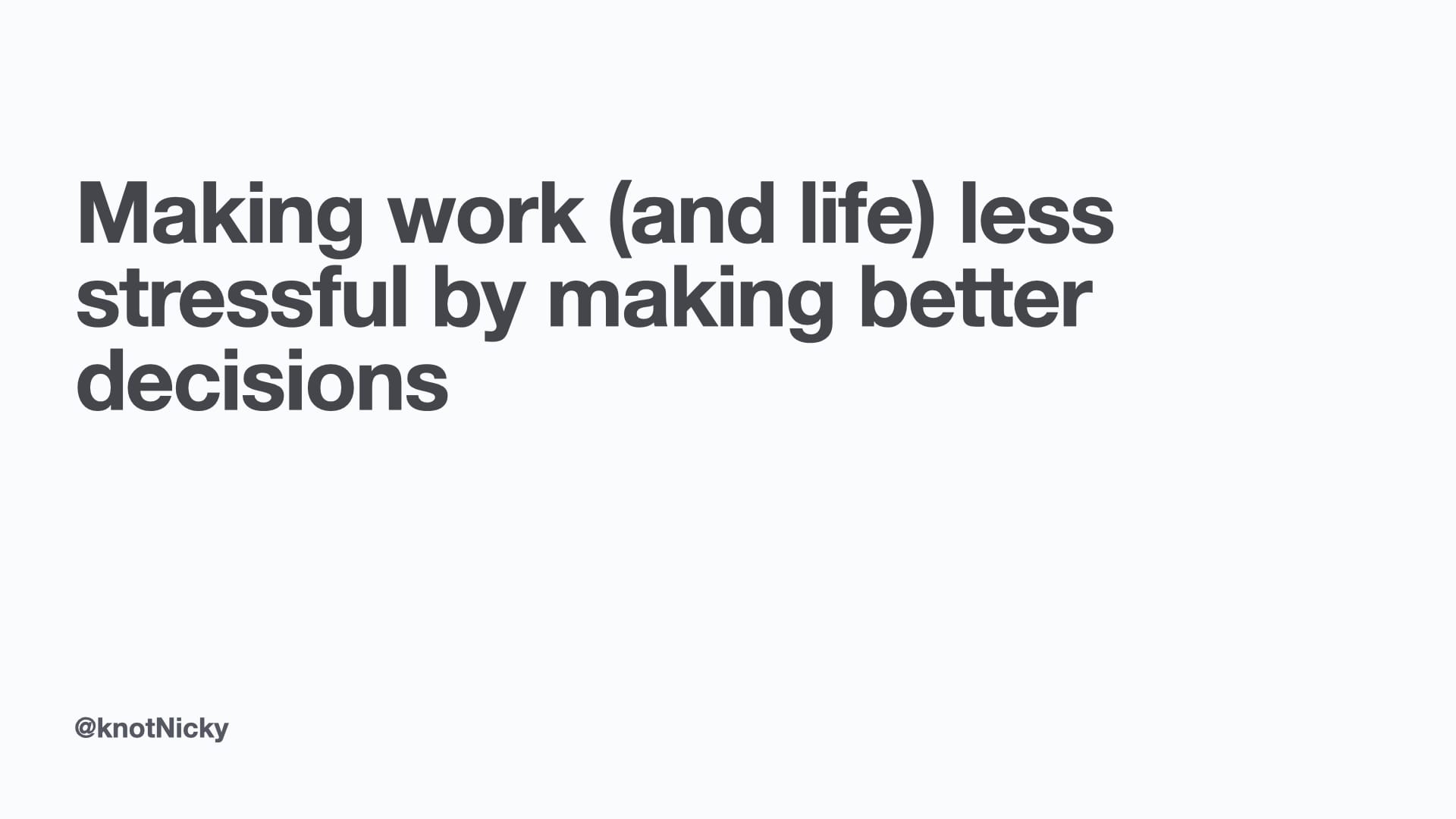
Hi everyone! I’m Nicky, and I’m going to be speaking today about making decisions.
But I’m not going to be speaking about team decisions, facilitating consensus, all of that. We’ll touch on it in a few places, but really that’s a whole other talk. Today this talk is really all about YOU, about your mindset shift. Because by focussing on yourself first, you can lift up everyone around you. Ok.
So I’m going to start with a visual guide to my entry into leadership:

So when I started managing teams I didn’t realise it was going to be quite such a rollercoaster.
And honestly at various times I have felt like all of these people:

My first day. I felt pretty good and quite excited!
But before very long...

I was slightly less excited, and kind of maybe a little bit terrified.
Because in quite a short space of time suddenly I had gone from feeling like “oh, great, I get to make all these decisions” to “oh, great, I’ve got to make all these decisions”.
And then - even worse...

Sometimes I felt like this person with their head in their hands .. thinking “oh no .. I have made a very bad decision…”.
And this is not a great place to be hanging out, right? Because it feels bad to be wrong. It feels bad to make mistakes. It feels bad to make the wrong decision.
It’s one of the things I find most stressful about work - and life in general. When you get that sinking feeling that something has not gone well.

So I wanted to share some of the things I learned on the way that got me to this place where I might not always make exactly the right call every time, because that is impossible. But I got to a place where I’m happier because I know I’ve got solid foundations and good processes and I’m considering the right aspects to make better decisions.
Because we all start somewhere. Maybe you just got promoted and your boss used to do all this stuff, and they didn’t write down how they did it
Or they left, so you can’t even ask them, and now you’ve got to figure it out. The first time you have to make a really difficult call with no clear right answer. And the consequences could be significant and long-lasting. For you, and for others.
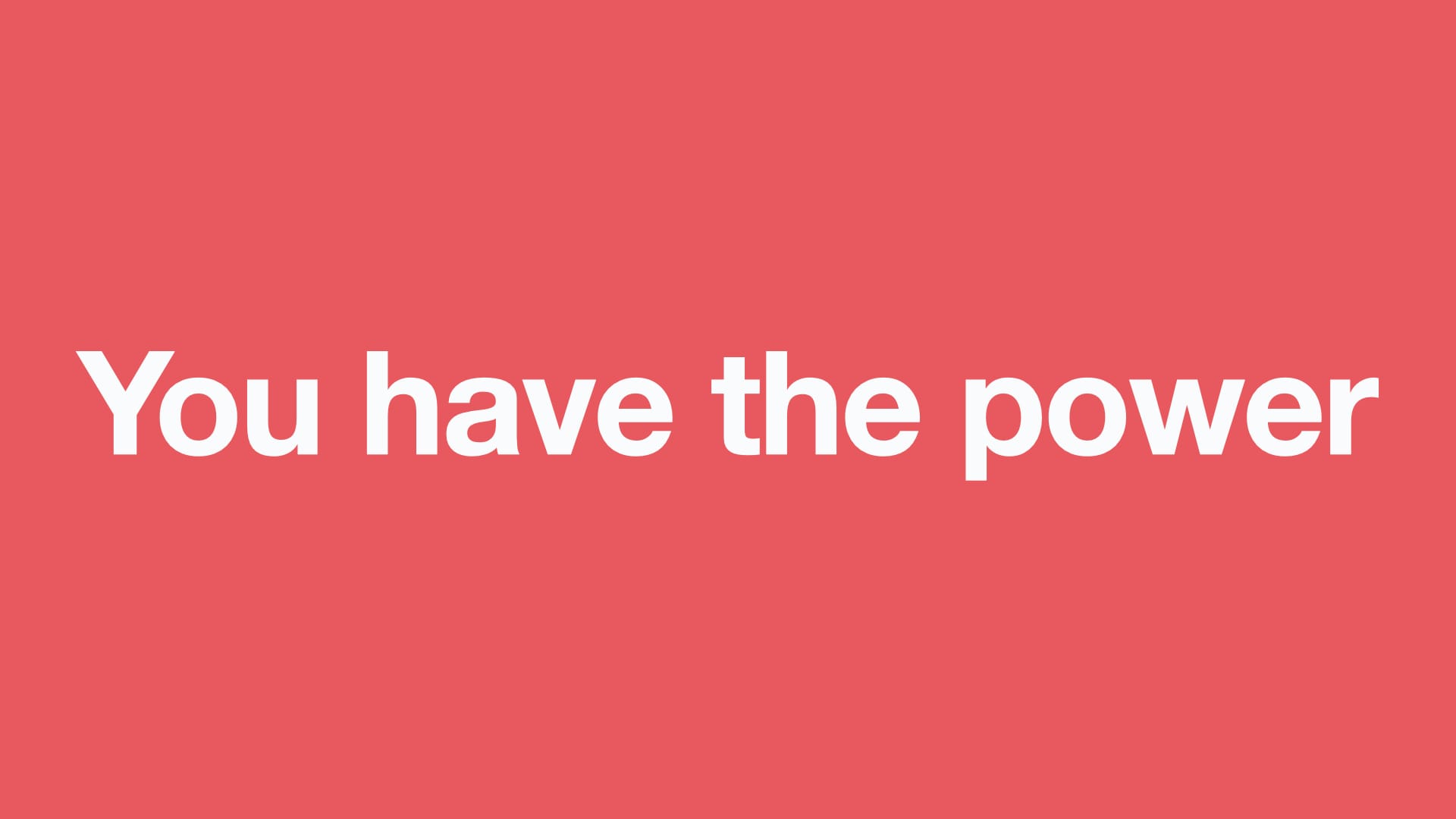
Because we, all, here, as engineering leaders, have the power to make work better, and avoid those consequences for ourselves and our teams, by making more informed decisions.
And it’s hard, but it’s important. But there are some things we can do, that can help us do better.
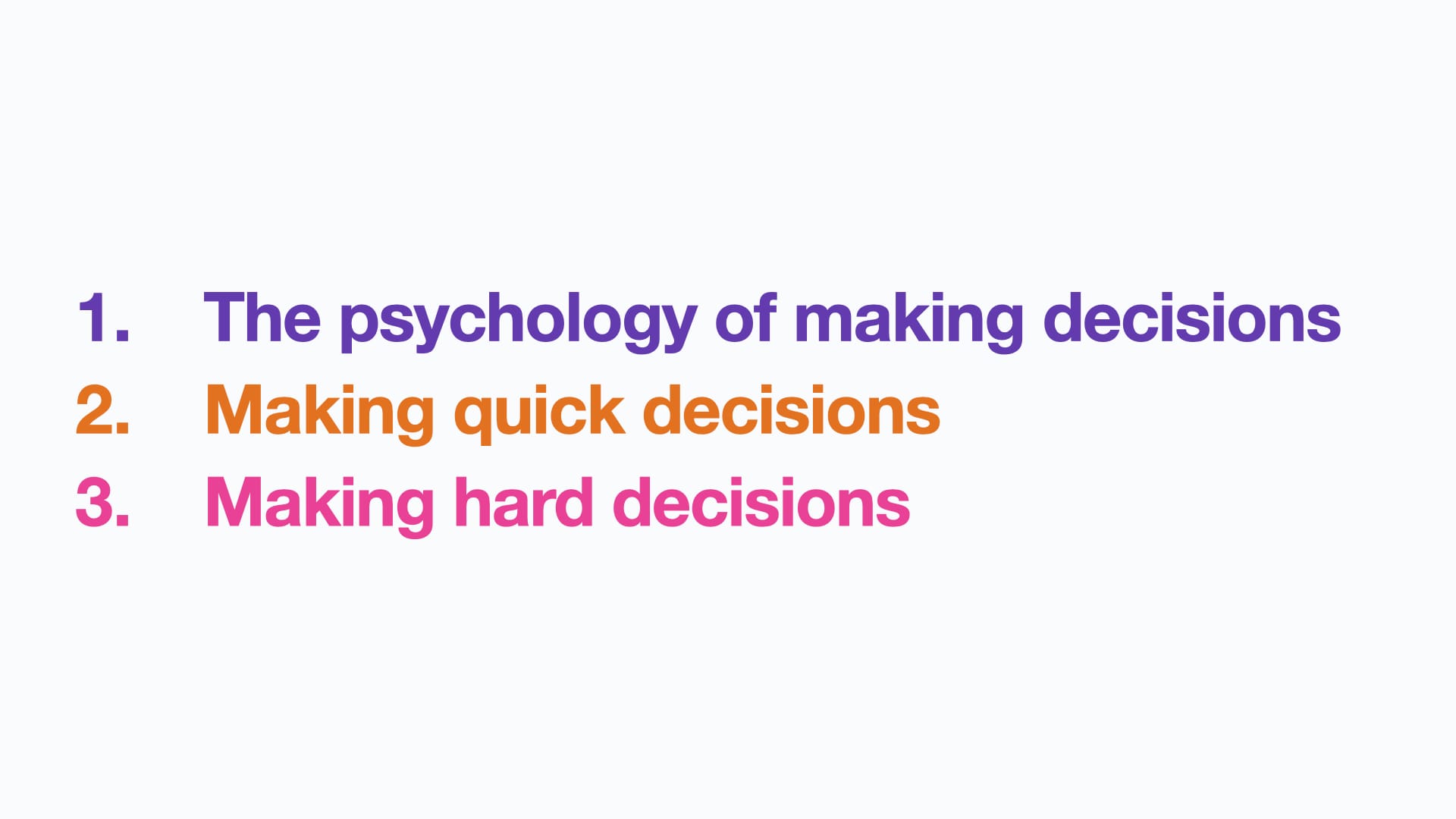
So, here’s what we’re going to be talking about today.
We’re going to look at some of the theory and science behind making decisions.
And then look at some practical tips, first: to see how to figure out if we can be decisive and make a choice quickly.
And then - some tools to use when we need to make harder decisions.
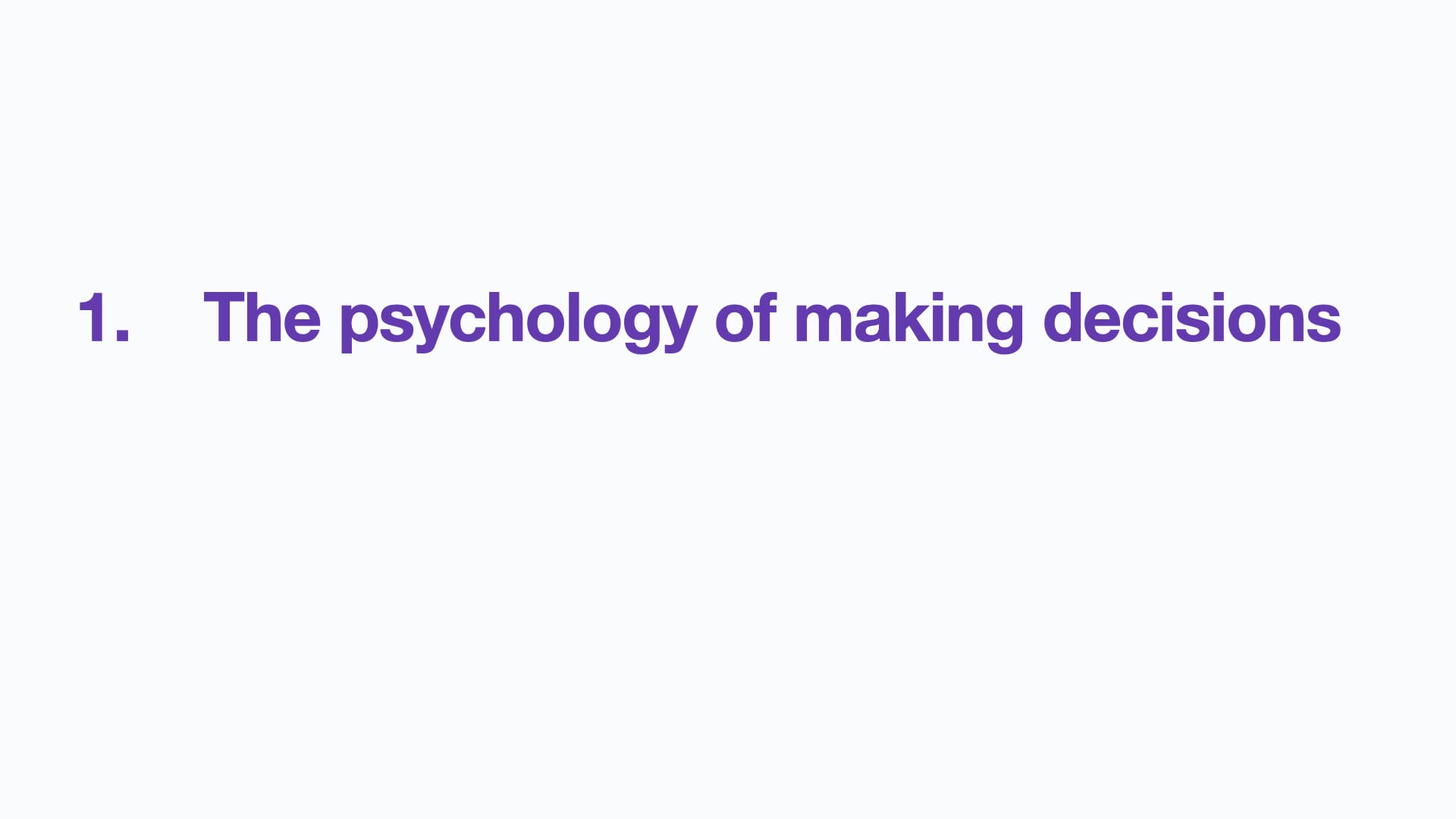
I first got into this topic because I enjoy playing poker as a hobby. In the game of poker, players must continually make decisions about how to play the hand they were dealt. If they consistently make bad decisions, they will lose the game.
I also enjoy reading, so naturally I read some books about poker. One of these, by Annie Duke, explored the different models that people use to make decisions, and the factors that go into that.
This lead me into reading more and more about our brains, and how they work.
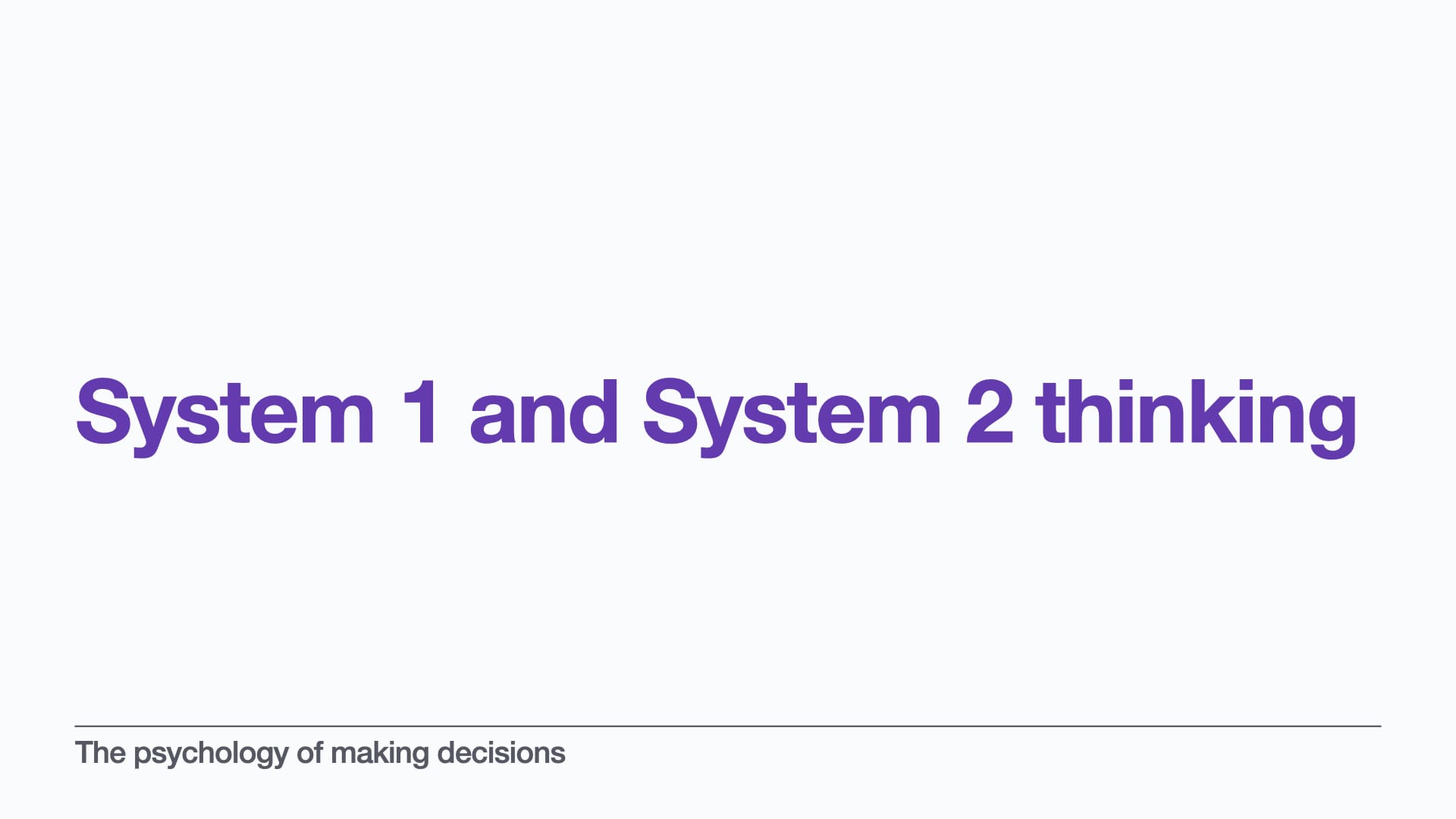
Psychologist Daniel Kahneman’s book “Thinking, Fast and Slow” explained that we have two different ways of thinking, System 1 and System 2. And we all have this system 1 and 2 thinking.
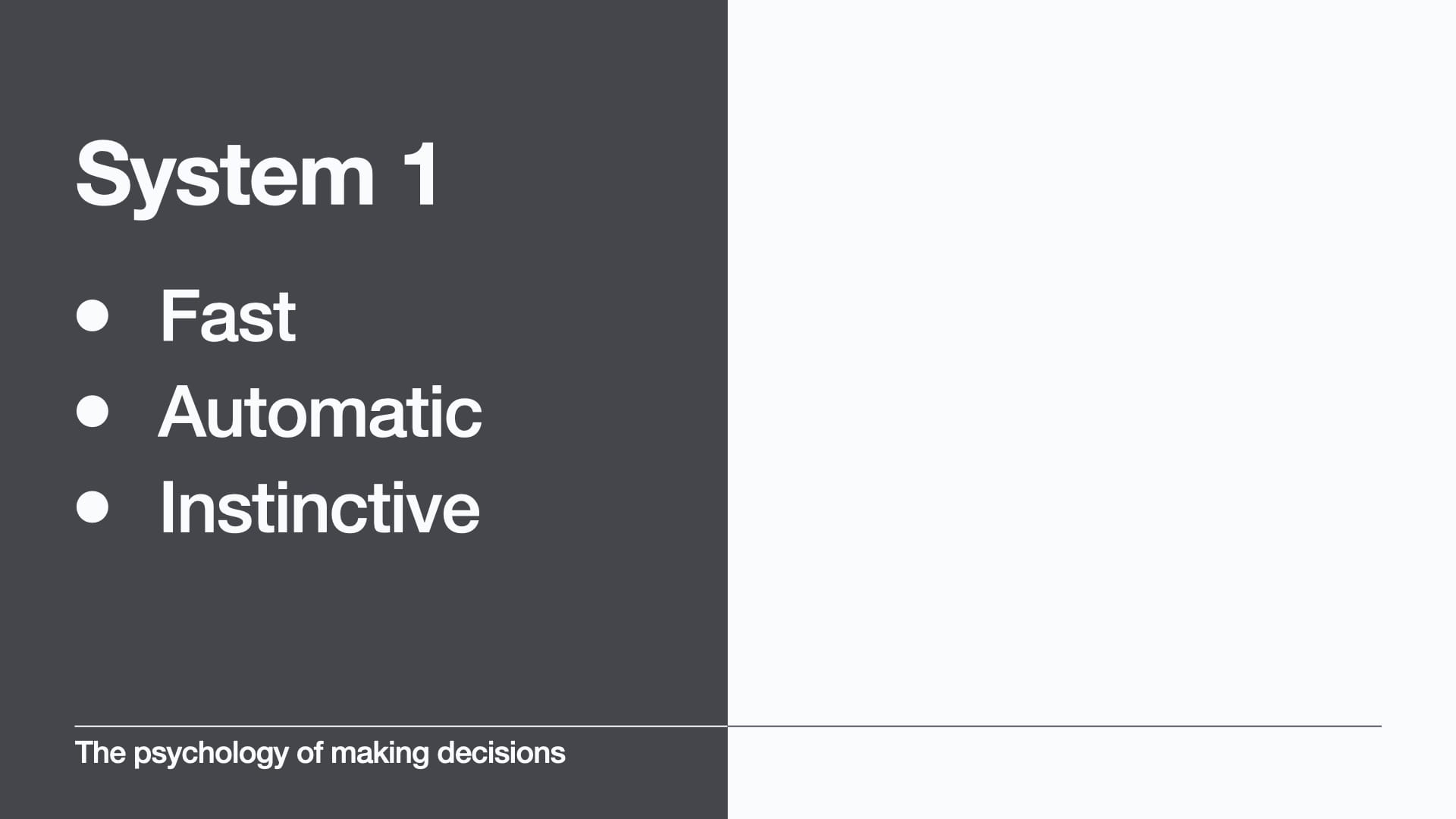
System 1 is fast, automatic, instinctive, and it provides very quick emotional responses. System 1 is what stops you walking into the road because you can hear traffic. System 1 thinking is associated with our amygdala - our fight or flight response.
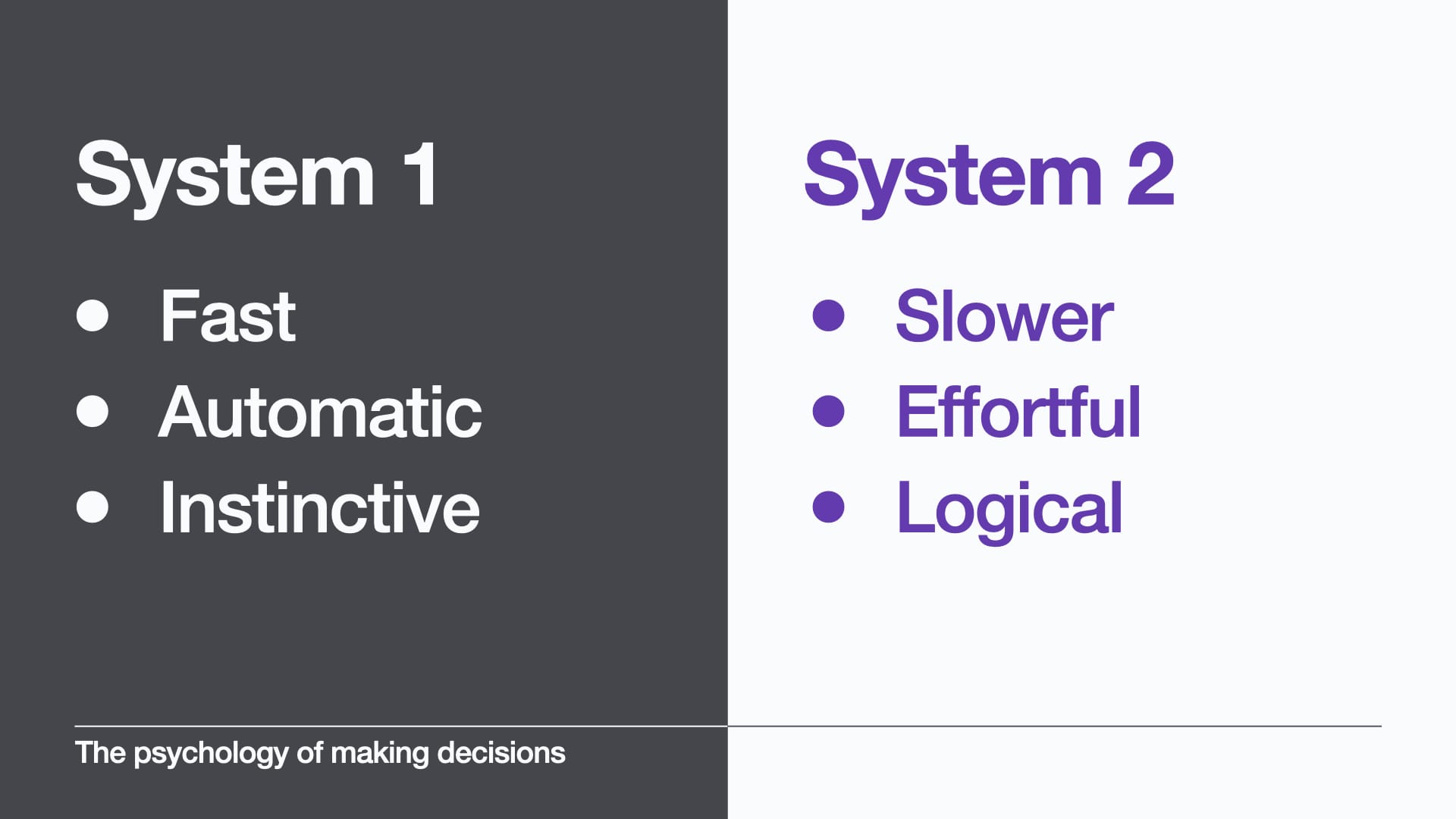
System 2 is slower, it’s when our conscious reasoning kicks in. It’s when we’re being more rational. System 2 is about solving difficult problems, when we’ve taken the time to understand what’s happening and make a conscious choice about what to do next.
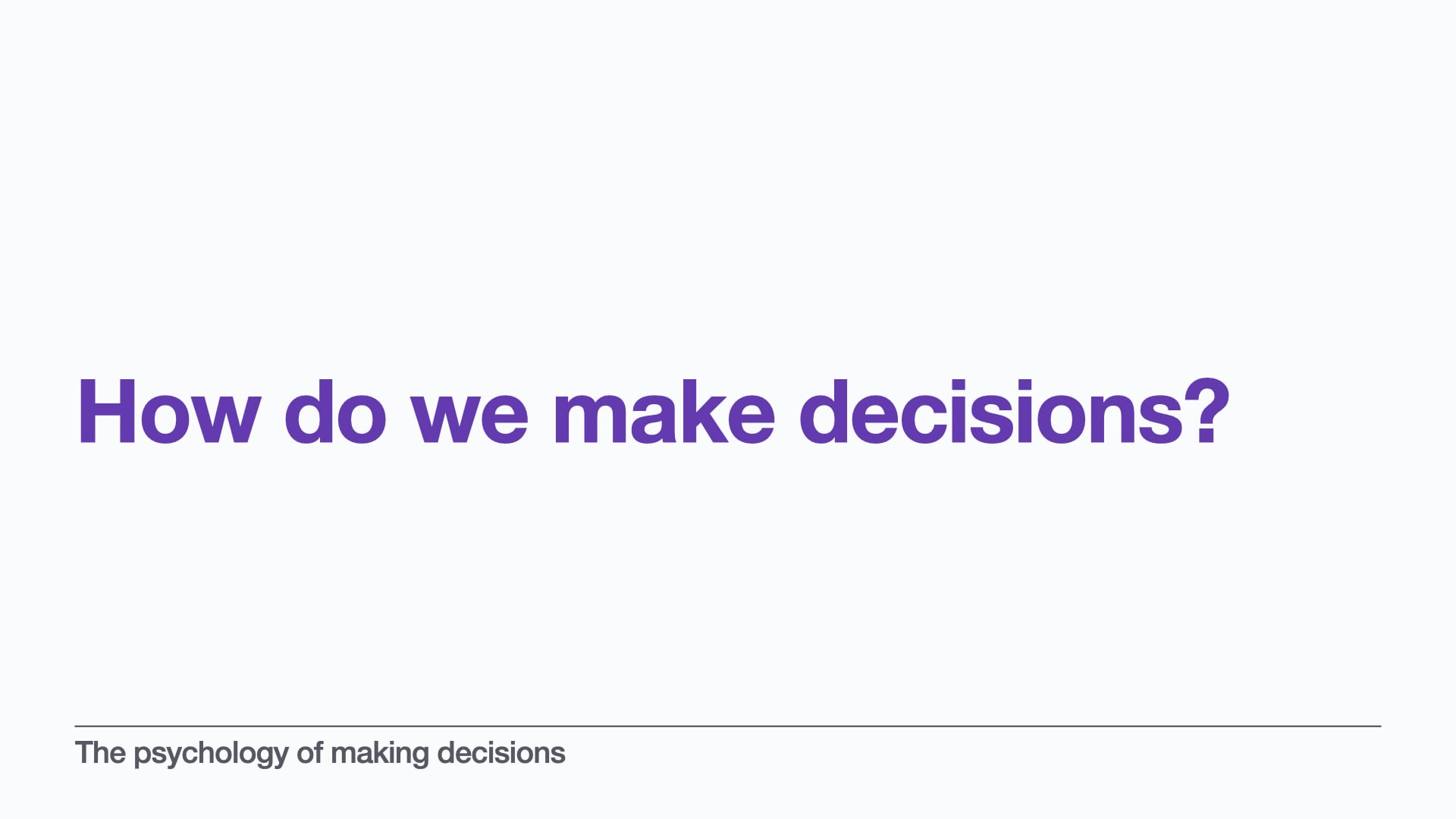
And the more I read around this subject, the more it happened that I turned up to work the next day and could see these ideas in action as me and my colleagues worked through problems together.
And what became clear to me, is that our decisions are based on our beliefs.
So first of all, it sounds really basic but I just want to make sure we’re all on the same page: we’re gonna go DEEP into this: what is actually happening in our brains when we make a decision.
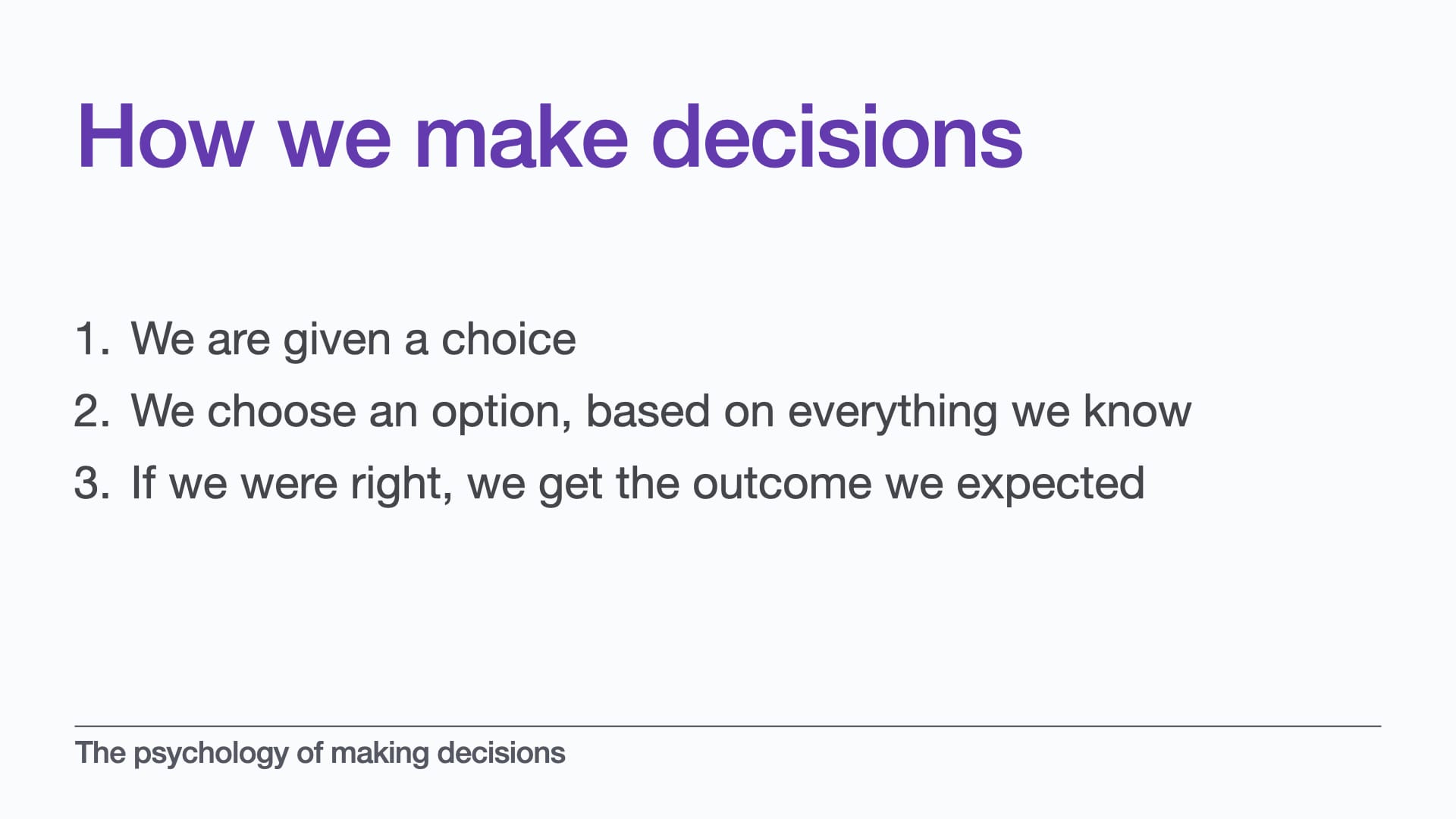
This is the purest form of a decision, and it looks great in theory. But we’re not in an ideal world.
We probably don’t know everything.
Because what’s actually happening is more like this:
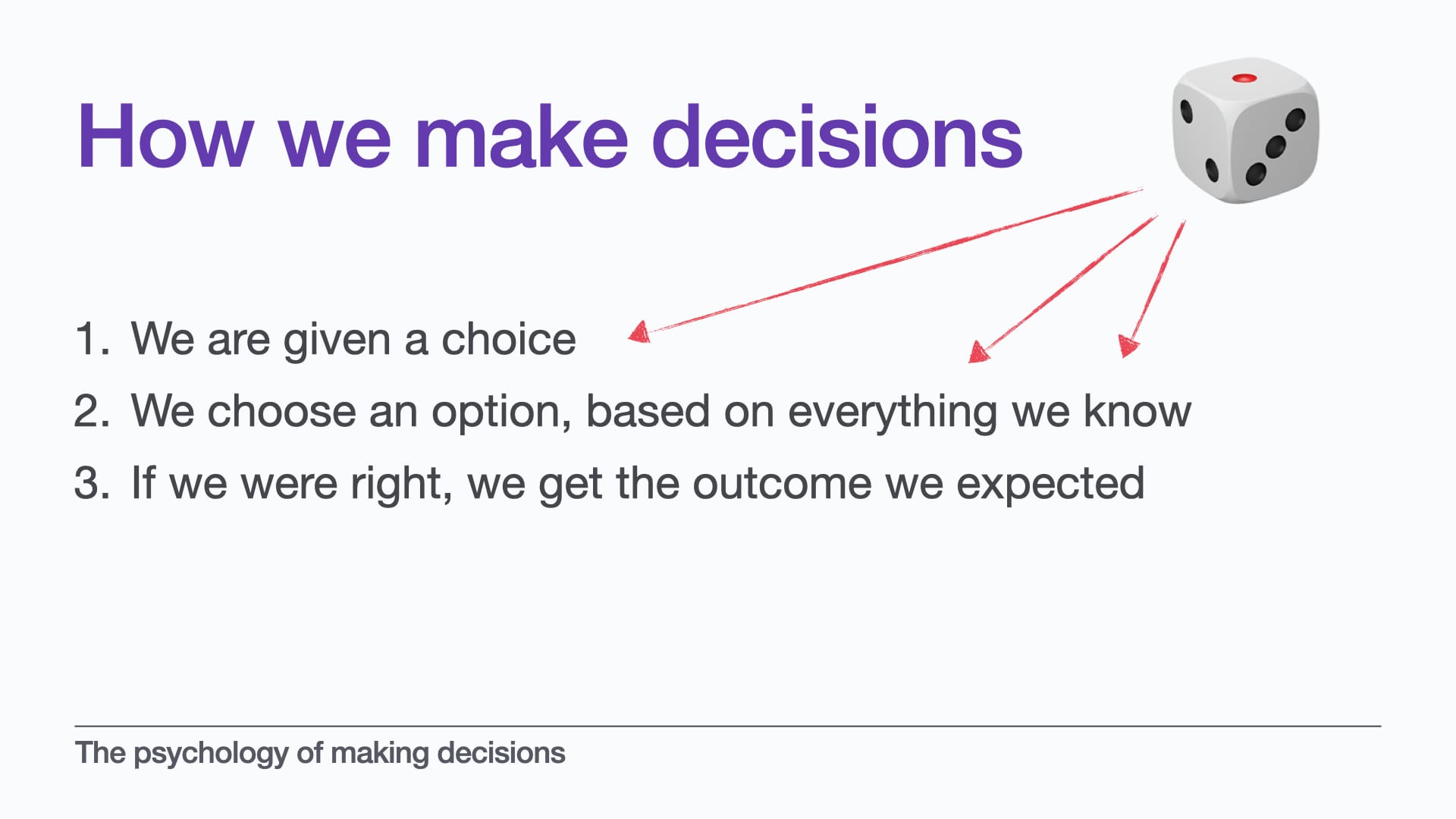
The first problem is that we don’t control all the variables. If we had perfect knowledge, in theory we could always make the perfect decision. But most of the time, we make decisions in an environment we don’t control completely. There might be factors we didn’t know at the time, or things could have changed afterwards.
The second problem is that our decisions are based on our beliefs. And unfortunately there is some bad news about the way we form beliefs.
In addition to the rest of the world - and other people - getting in the way, and the dice being rolled:
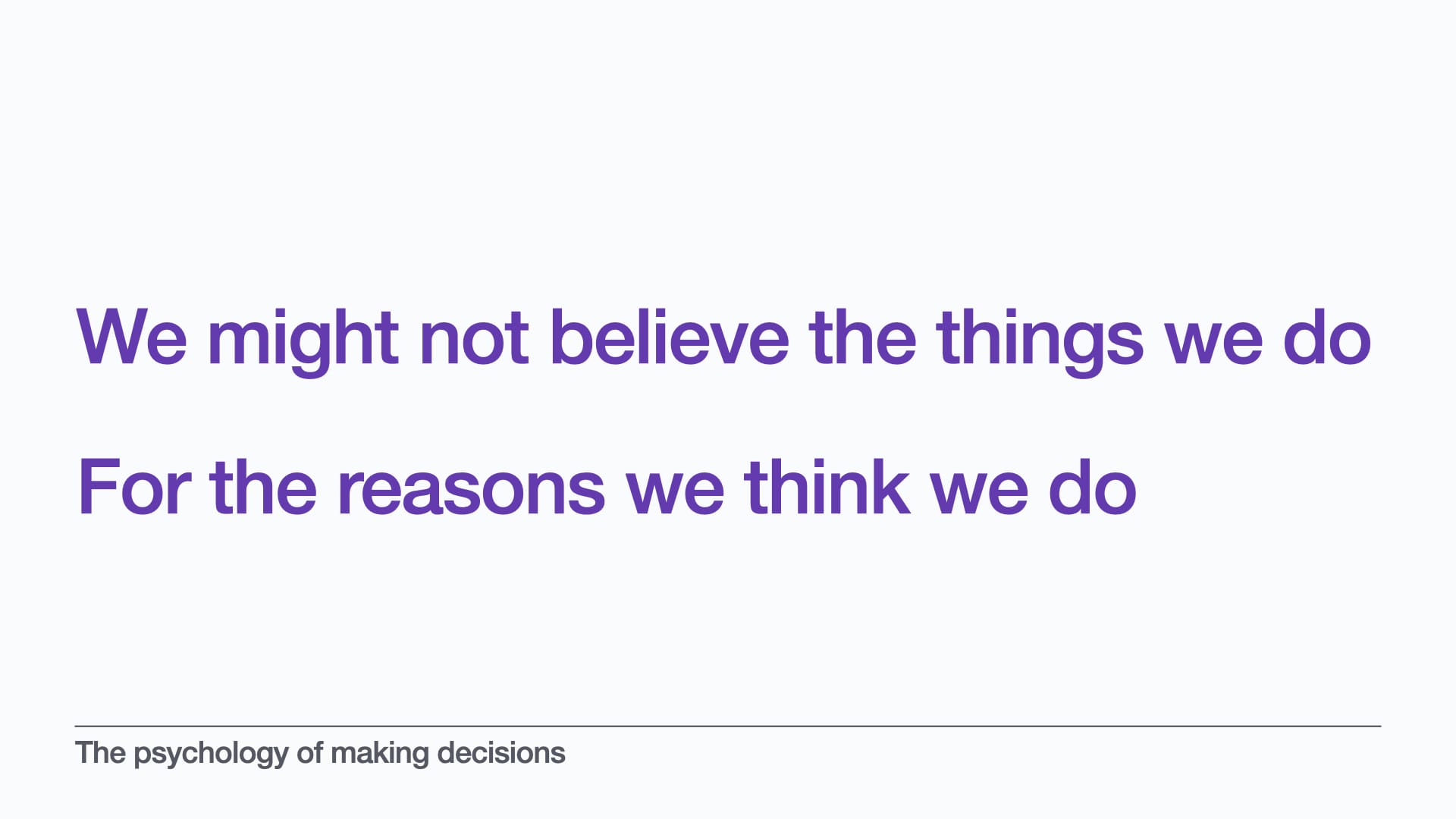
We might not believe the things we do, for the reasons we think we do.
This means that beliefs that we hold, that maybe we haven’t recently examined very strongly, could be informing our decision making, if we’re not aware of it.
Because we all have hidden biases. We all have blind spots
Even if we don’t think we do. We do.
We all filter everything through our own experiences and expertise which leaves us with these blind spots. We can’t get rid of them really, entirely.
But we can learn to identify them. And reduce the times in our lives that we rely on them.
Because our bias can creep into our decision making, if we’re not aware of it.
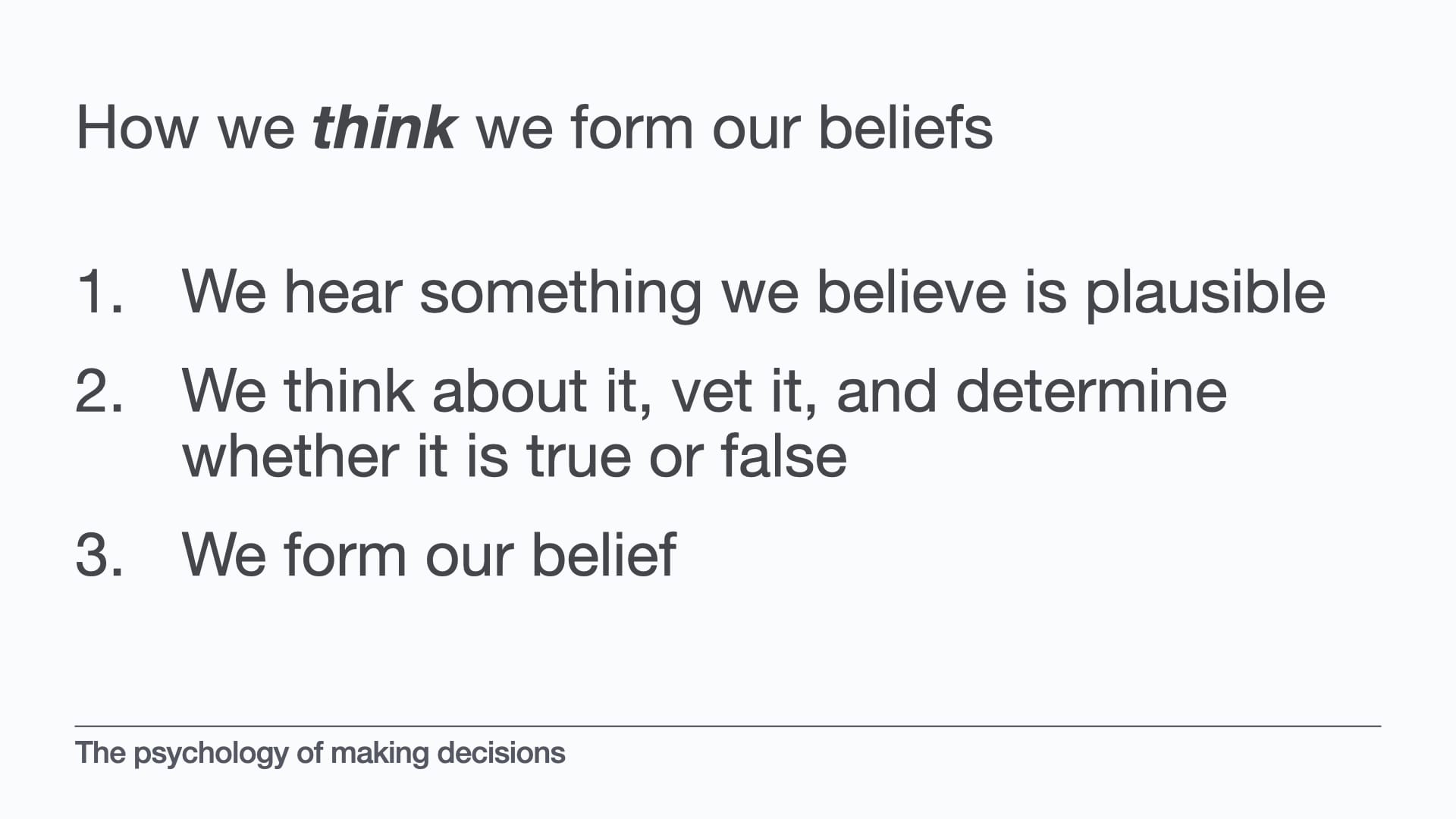
Because we like to think that we are these perfectly rational actors, and we form our beliefs by engaging our system 2 thinking to take in all the relevant information and vetting it, to discover the truth.
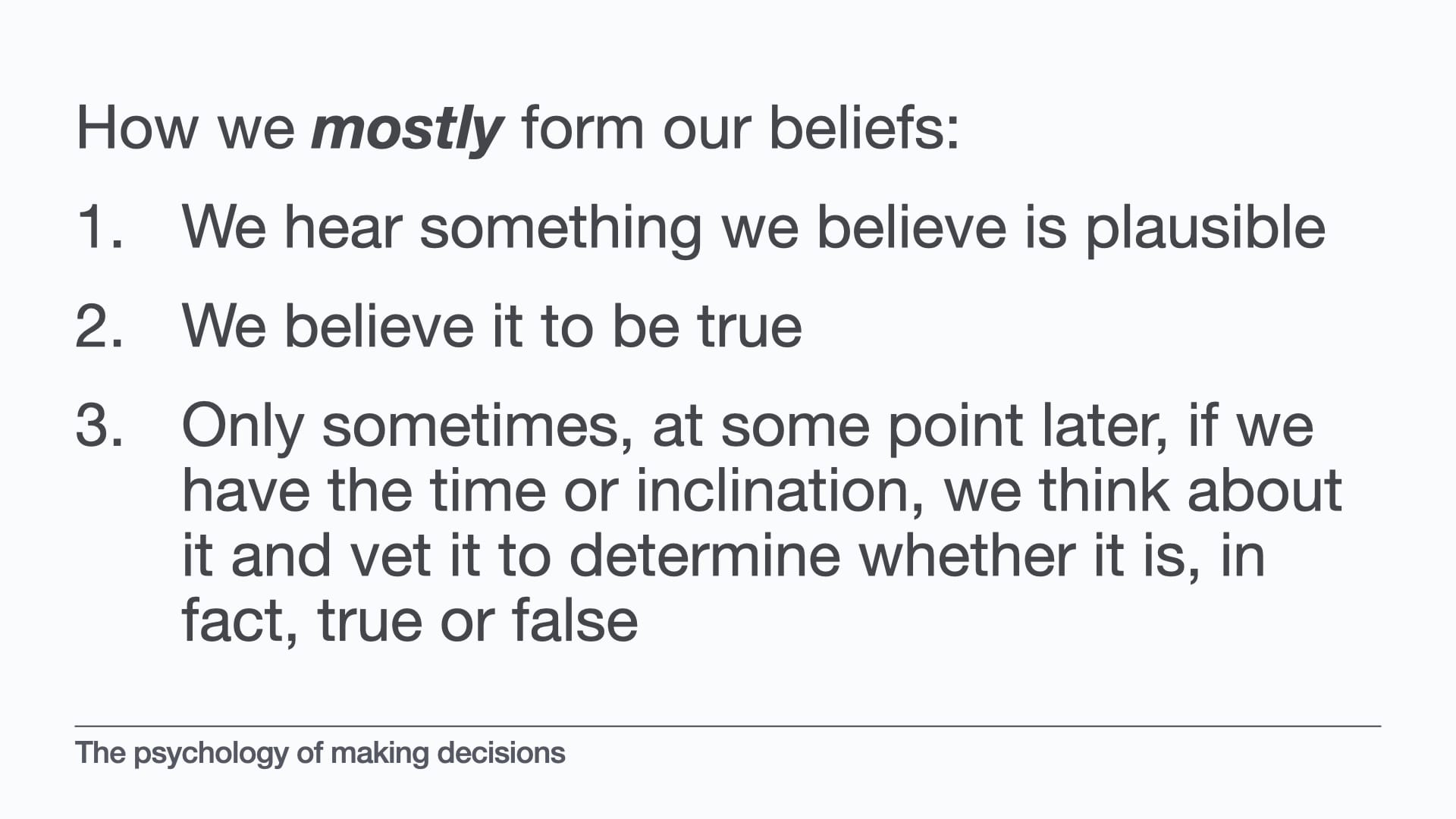
But ultimately this is what is really happening. System 1 often jumps in to pattern-match.
We all unconsciously prefer data which supports and reinforces our existing hypotheses. It’s very easy to get set in our ways.
Confirmation bias is a thing, right?? Motivated reasoning is a thing.
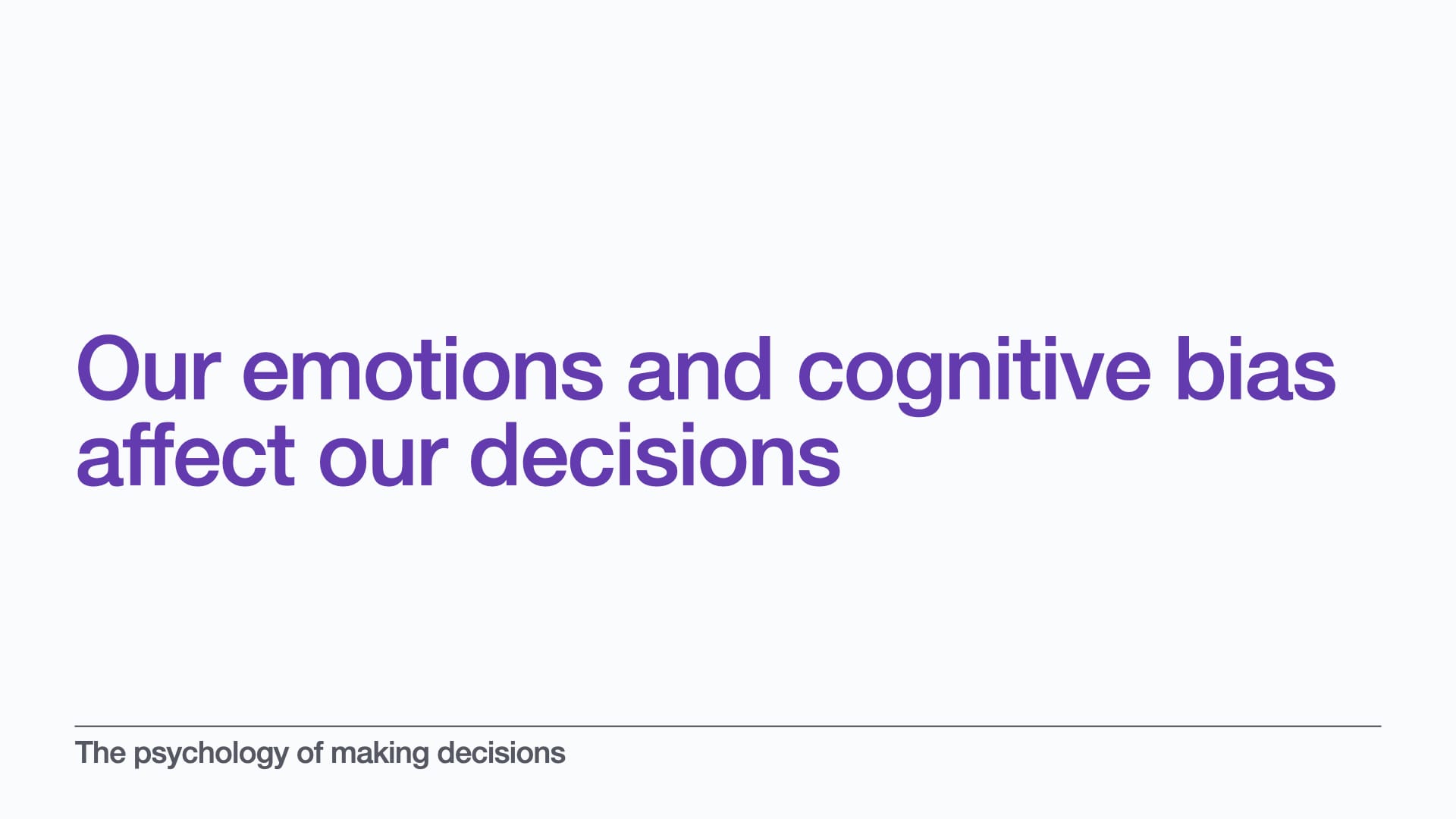
And our beliefs are very stubborn things. We want to think of ourselves as these rational actors, bringing our system 2 thinking into it, but research shows otherwise. We don’t often take that time to update our beliefs based on new information.
We want to think of ourselves as rational actors
But we are not, always. Feelings come into it, our system 1 thinking very easily causes us to make snap judgements.
And that’s where emotions can come into play, in an unhelpful way. Because the more we care about something, the harder it is to be objective, and the harder is to take in new information that contradicts our beliefs.
And the more comfortable it feels to leave our existing beliefs in place.
And there’s one more theory I’d like to share. It’s more bad news I’m afraid.
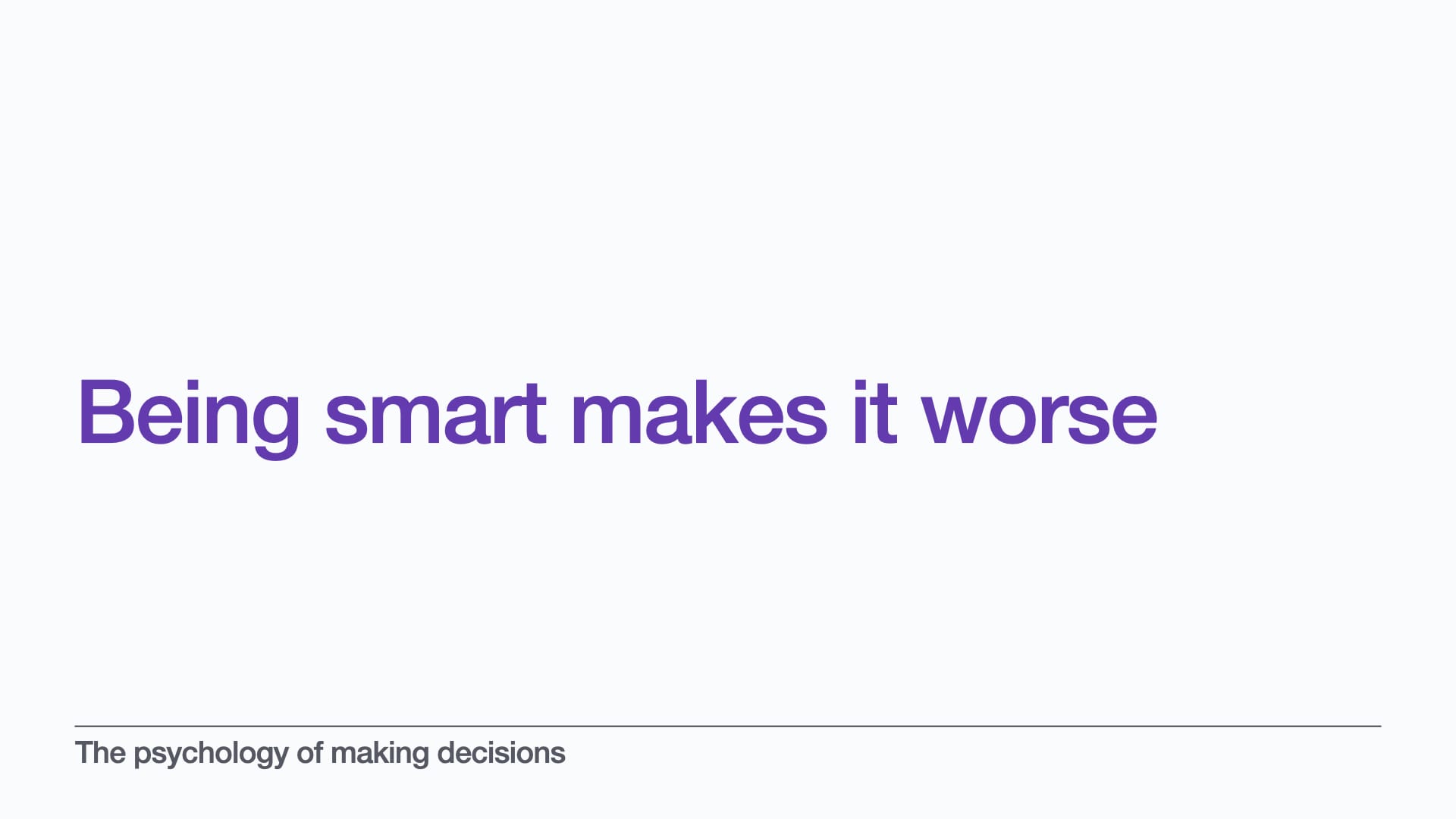
Being smart makes it worse. Oof! That’s annoying!
Well, ok, fine, but like, what do I mean by that? Makes what worse?
It makes it harder to recognise when your bias is creeping in.
Being smart is great! You all know that! Cos you’re all very smart. Being smart is all about effectively analysing and processing information, parsing the quality of an argument and the credibility of its source. Right?
…Sure. But being smart can make bias worse. Because the smarter you are, the better you are at constructing a narrative that supports your existing beliefs.
Smart people tell themselves better lies.
And it’s REALLY HARD to notice when this is happening.
So - that makes things a bit more difficult.
That’s the bad news section over with - no more bad news for today, I promise.
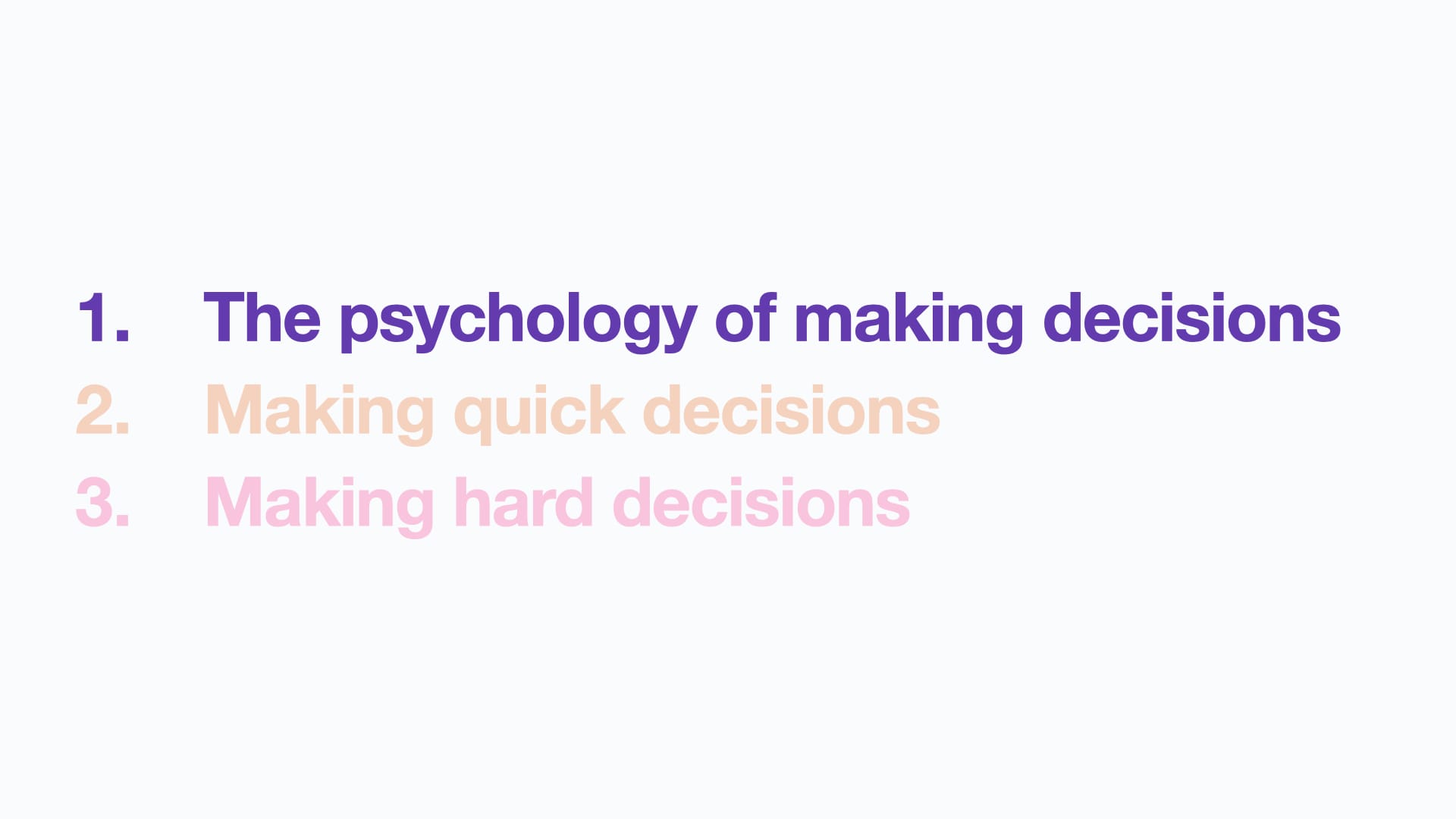
So we’ve explored a bit of the psychology of how we make decisions, based on our beliefs, and just some of the ways that system 1 thinking and cognitive bias and emotions can come into it.
It’s good to be aware of this. Knowing is not quite half the battle, but it’s definitely a starting point.
But how are we going to put this into practice?
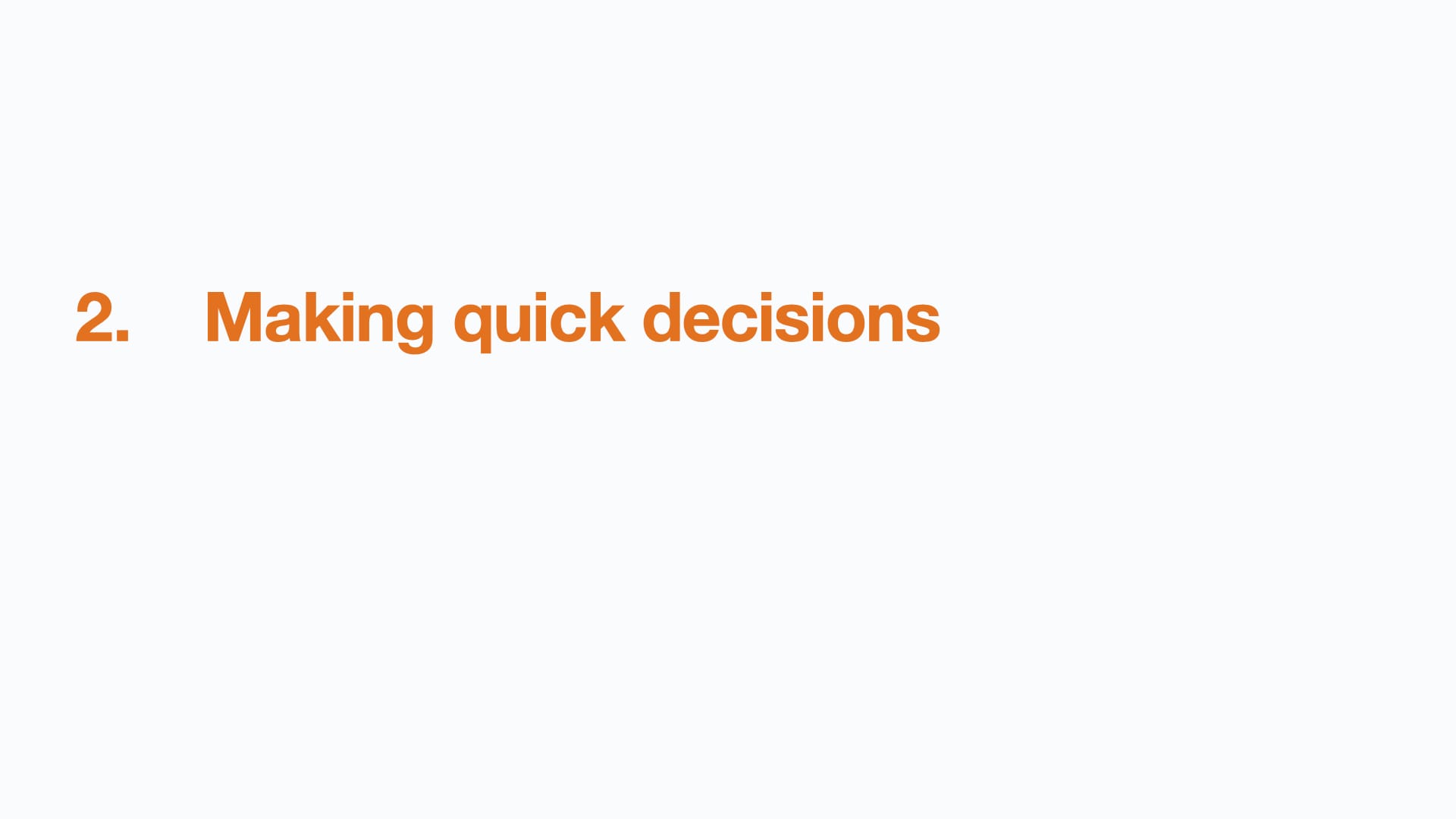
But, the first thing is to figure out - how much attention does your decision really need? I’ve definitely found myself agonising over decisions which in hindsight may not have needed it.
If you’re facing a tricky decision with multiple options, and you’re not really sure how to choose between them, and you don’t even know where to start, or how much effort and time to put in up front choosing between them, there’s some ideas we can use to help us figure that out.
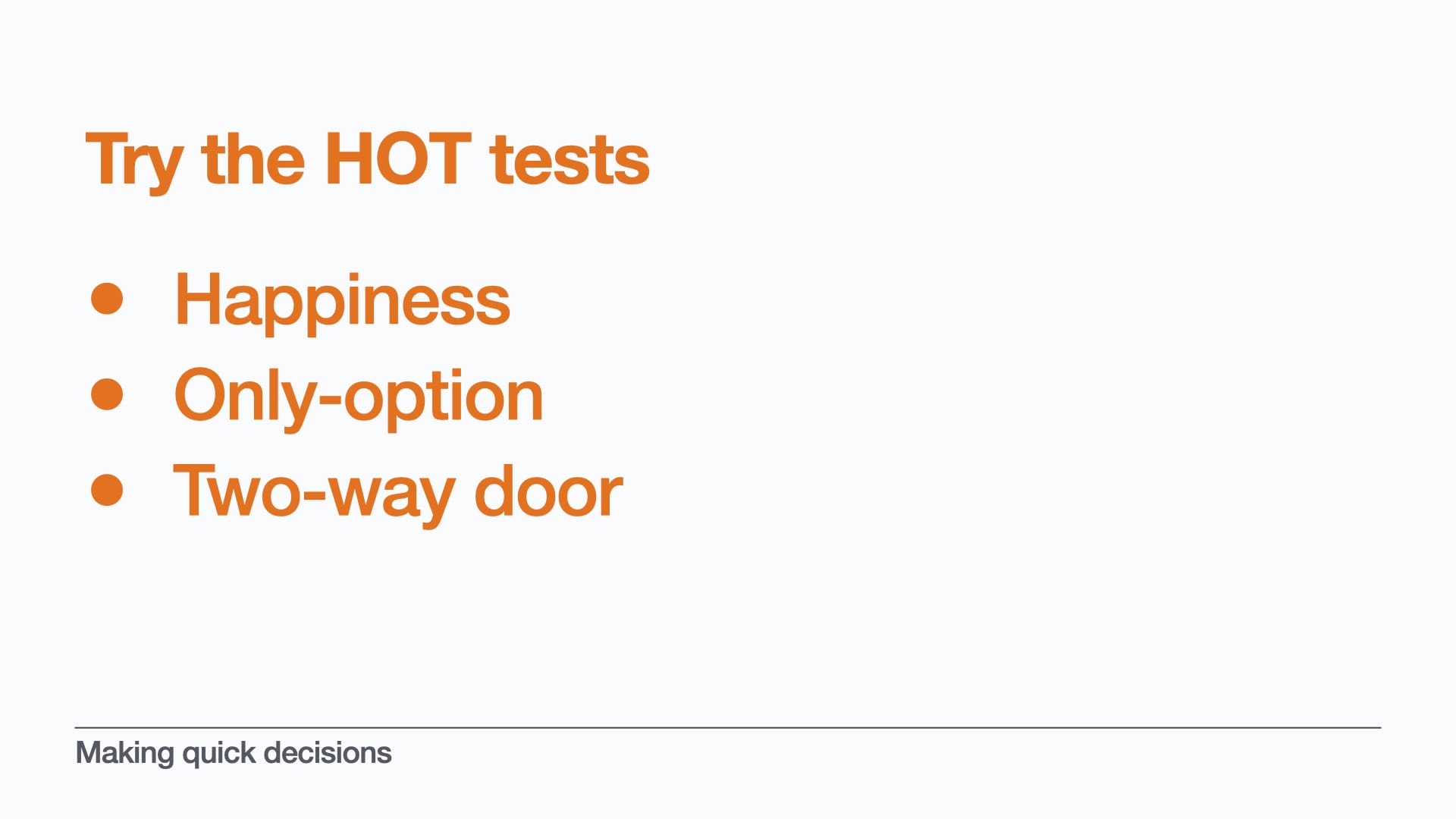
Annie Duke came up with this concept of these three tests, the HOT tests.
Assuming that you have done some research and you’ve got a few options to choose from.
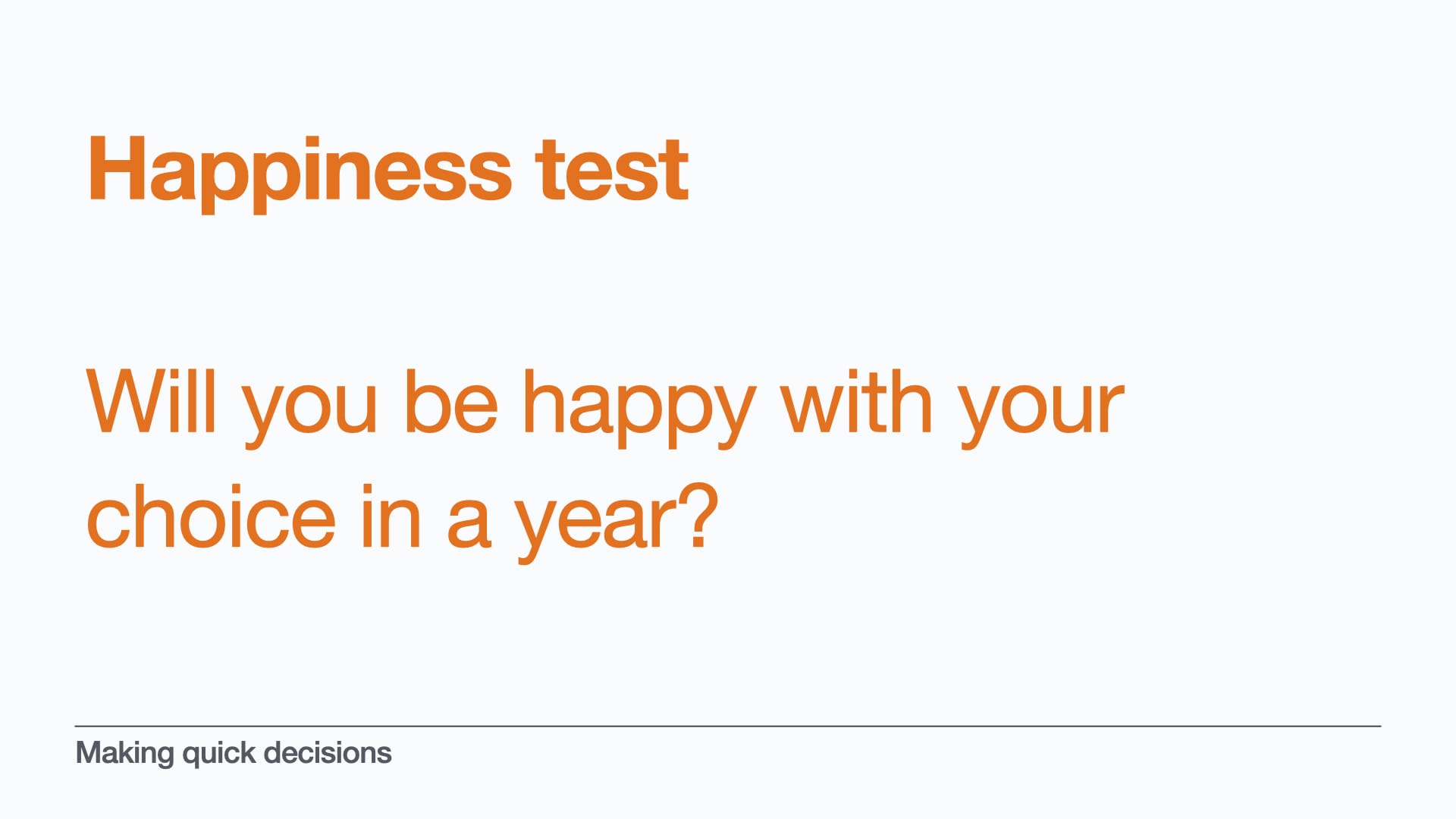
H is for the Happiness test. Will you be happy with your choice in a year?
If the answer is yes, the decision passes the test.
Think about this from your own perspective but also that of your team.
For a new project: if you’re making a throwaway prototype, your choice here will be very different to if you are knuckling down to build a service that will last for years.
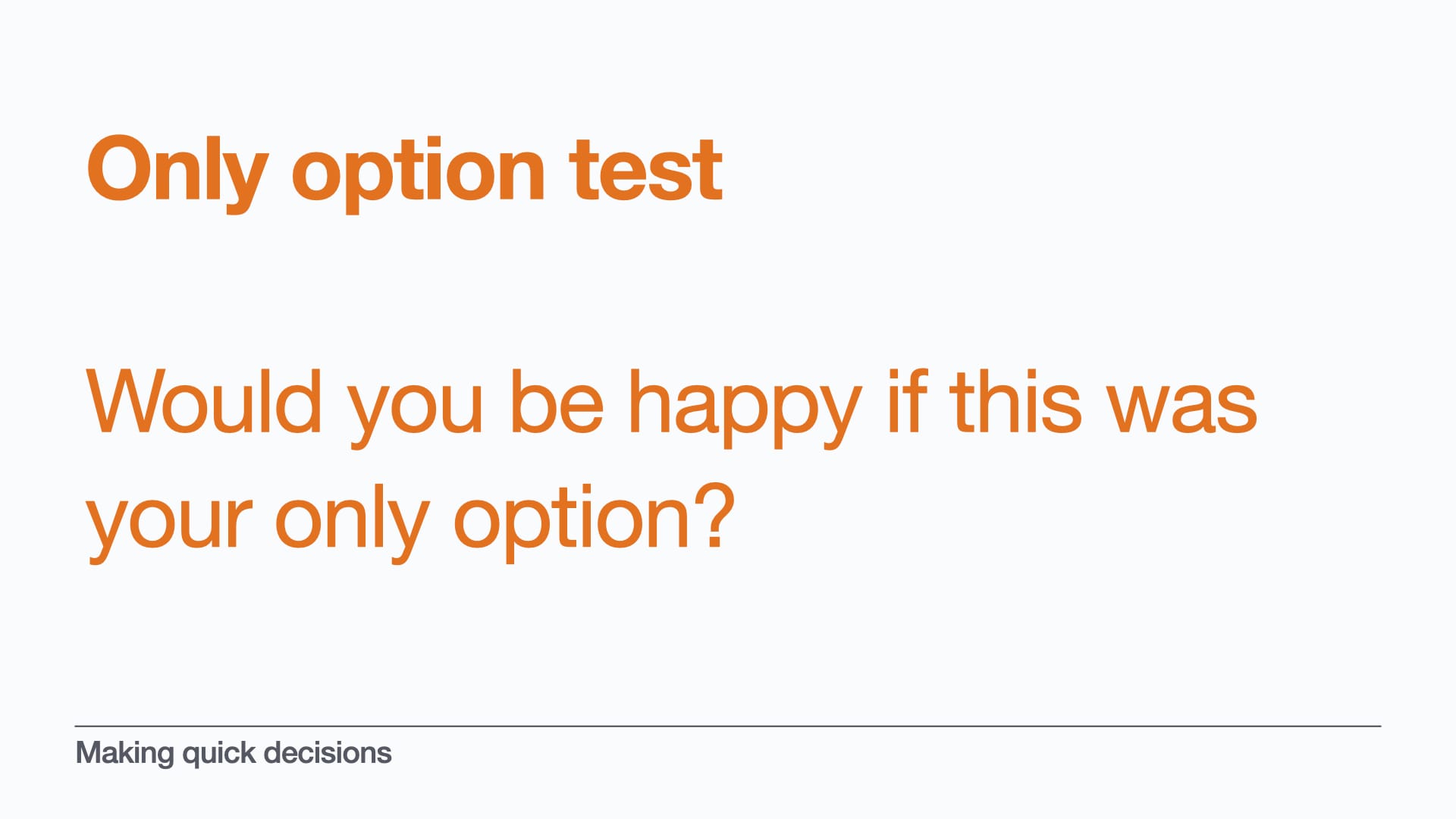
O is for the only option test.
If you have those multiple options to choose between, consider each one, in turn, on its own merits, without getting bogged down in comparisons.
Each time, ask yourself: would you be happy if this was your only option?
If you can answer yes, the decision passes the test.
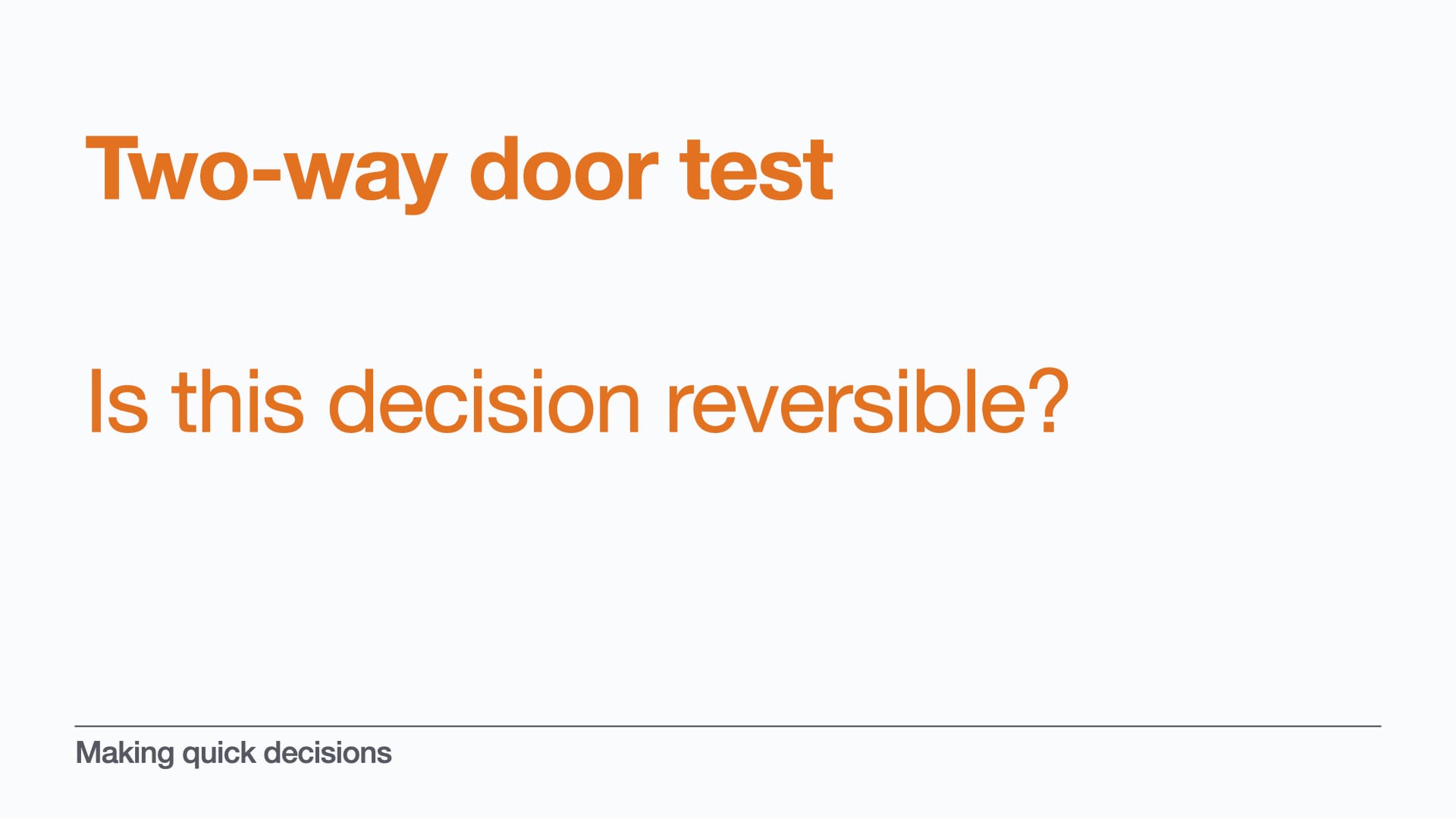
T is for the two-way door test. Is this decision easily reversible? Can you get a do-over?
If you walk through the door, can you walk back out of it to where you are now, easily and cheaply?
If the answer is yes, the decision passes the test.
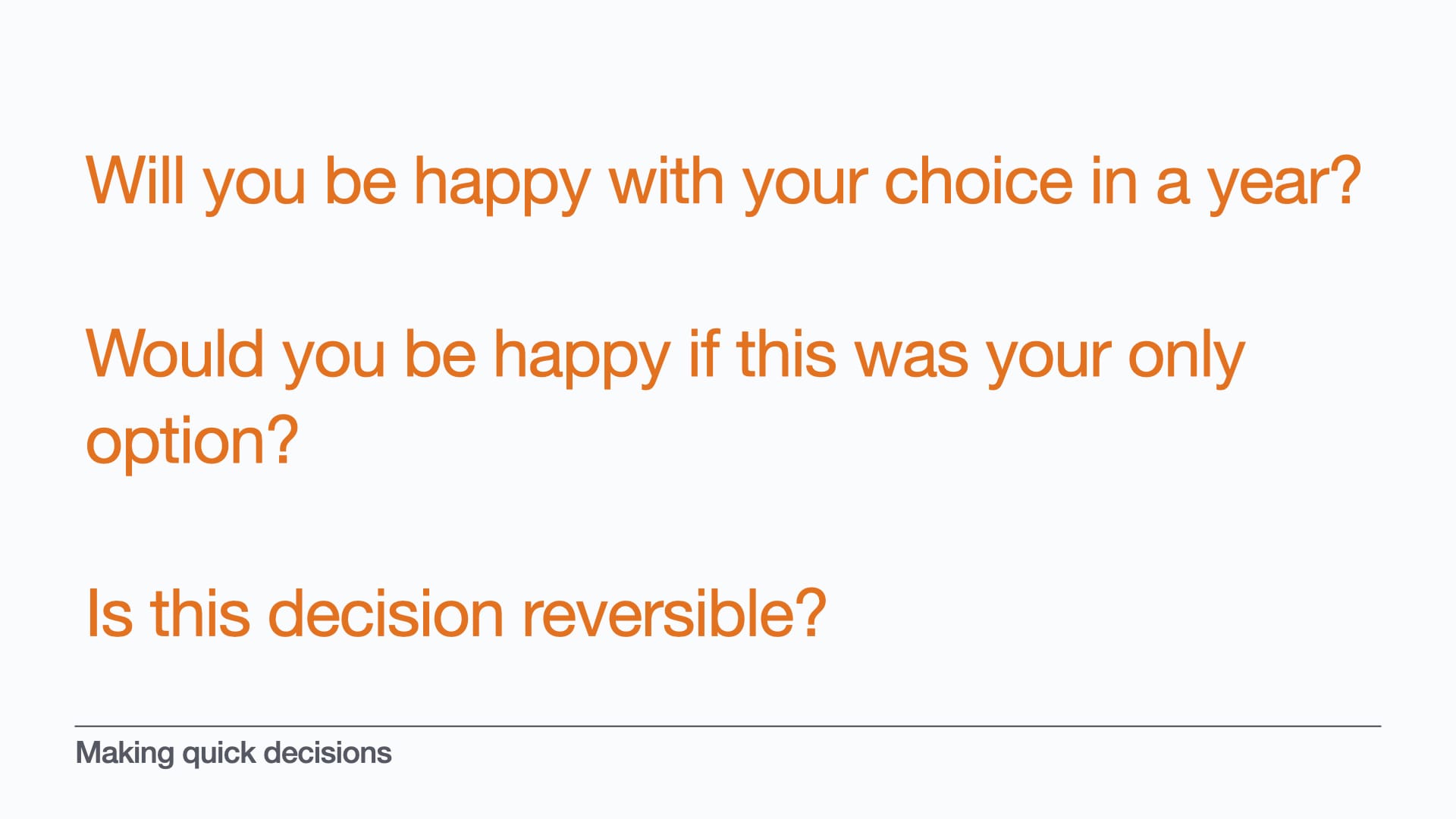
If you can answer yes to all 3 of these questions, you can be confident that you won’t regret making this decision quickly - and you probably should! Don’t worry about it too much, you can pick any of the options, or even flip a coin.
These tests are one way of avoiding that feeling of being stuck, of not being able to choose between options that are possibly going to end up quite similar in their effect, even if not in the details.
And recognising these types of decisions, and making them quickly, will give you more time for the decisions that aren’t so simple.
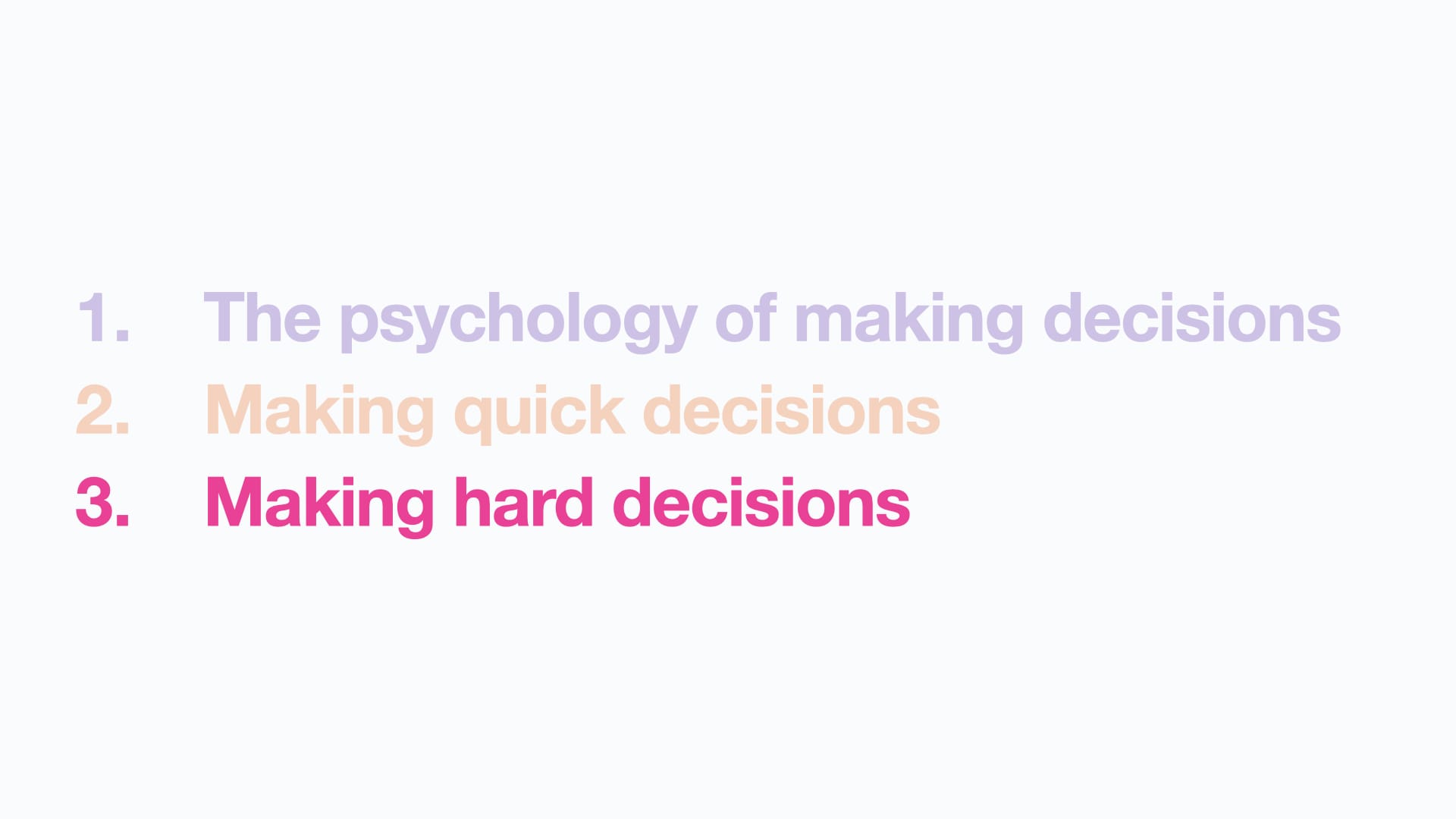
So you’ve done the HOT tests, and you couldn’t answer yes to all of the questions - that tells you that you shouldn’t make a very quick decision, so what comes next?
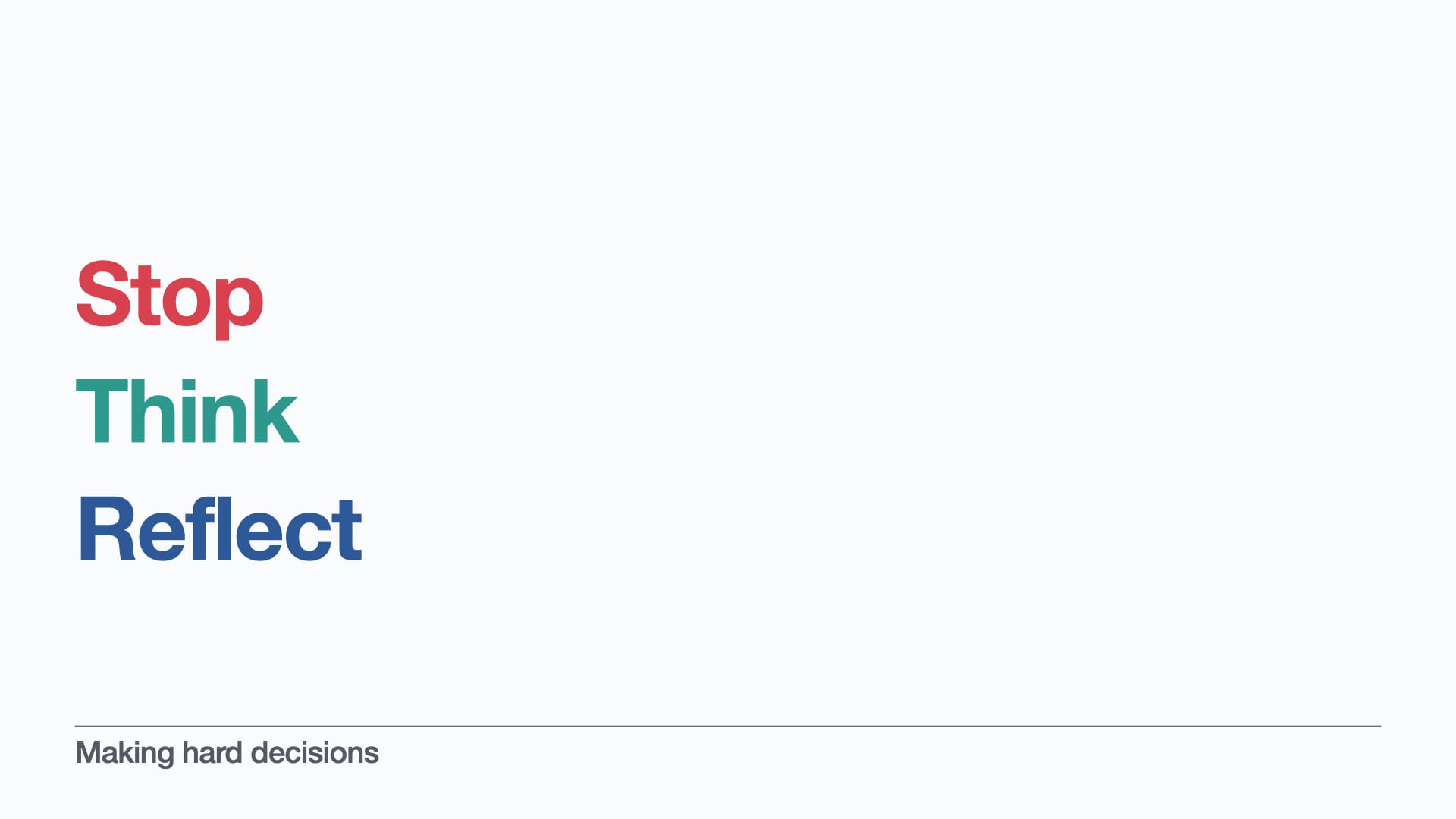
There are 3 parts to this:
- How to create that space and time to stop
- Some ways to make difficult things easier to reason about, to think about
- And some ways to learn from your experience when inevitably things don’t go according to plan
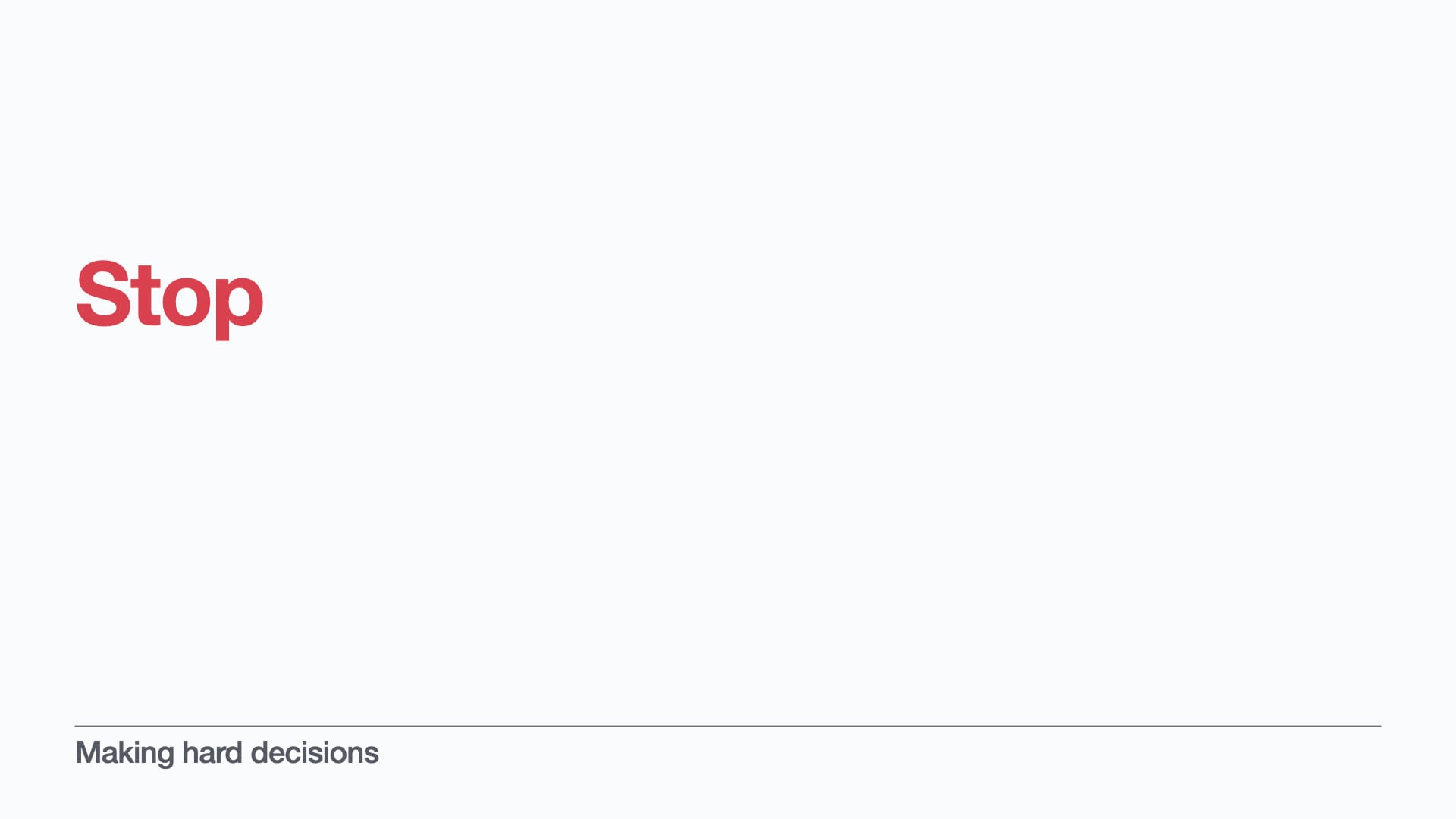
Some decisions feel urgent - perhaps somebody is waiting for an answer, or you’re just busy with other work. But you’ve done the HOT tests and know that you shouldn’t make a quick decision.
That’s the time you need to create a “stop and think moment”.
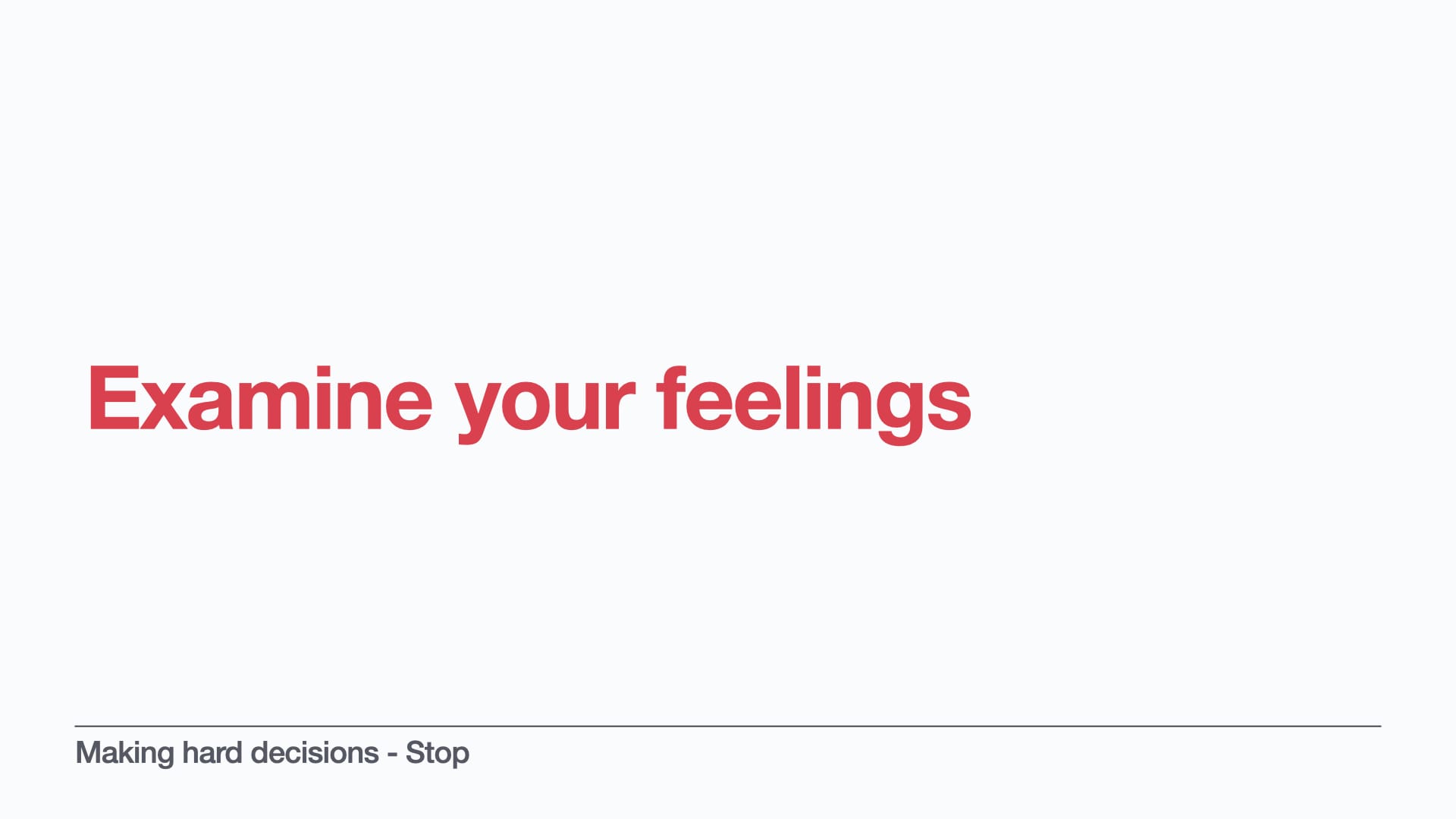
We saw how our psychology, our brains, and our emotions can hinder us from being objective. But we are squishy humans who have feelings! We can’t help that.
But we can actually bring our emotions into this, in a helpful way.
If I hear some evidence for a decision, I try to remember to ask myself: how does this make me feel? Do I feel vindicated or smug? Am I thinking: “Well, I knew that person was going to be trouble!”
Or do I feel anxious, angry or afraid? Am I in denial, scrambling to find a reason to dismiss what I’m hearing? Am I immediately jumping to thinking: “No, absolutely not, there’s no way my report could be responsible for that!”
Honestly identify your feelings in that moment - they can be an indicator that you need to take a step back, create a “stop and think moment” and re-evaluate.
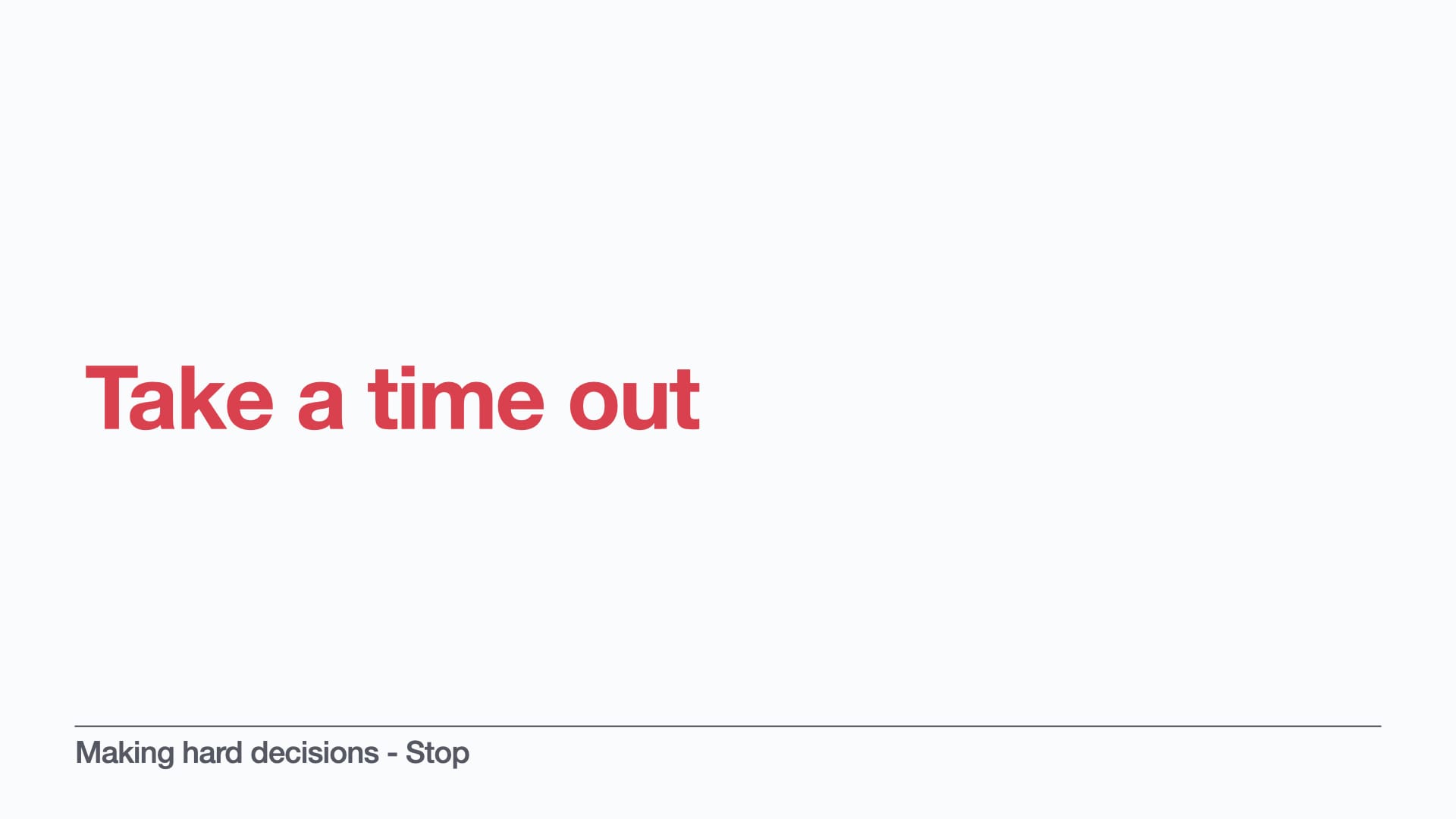
Or just take a time out. In your team, make it ok for anyone to put their hand up and say “I’m not comfortable with this proceeding as it is, can we pause this?"
It might be that you need to gather more information before you can come to a conclusion.
It might be that you need to set aside time to have specific conversation about it, because you need that back and forth.
Or it might be something like, if you've seen Amy's brilliant talk earlier about periods at work, you might make it ok for yourself or others to say "I've got an excruciating period cramp, can we reconvene in an hour?"
Because there aren’t really that many decisions that must be made right now, in a snap.
You’re the leader now, so it’s ok for you to show that sometimes you need to take some time to think about things, and make it ok for others to do that too.
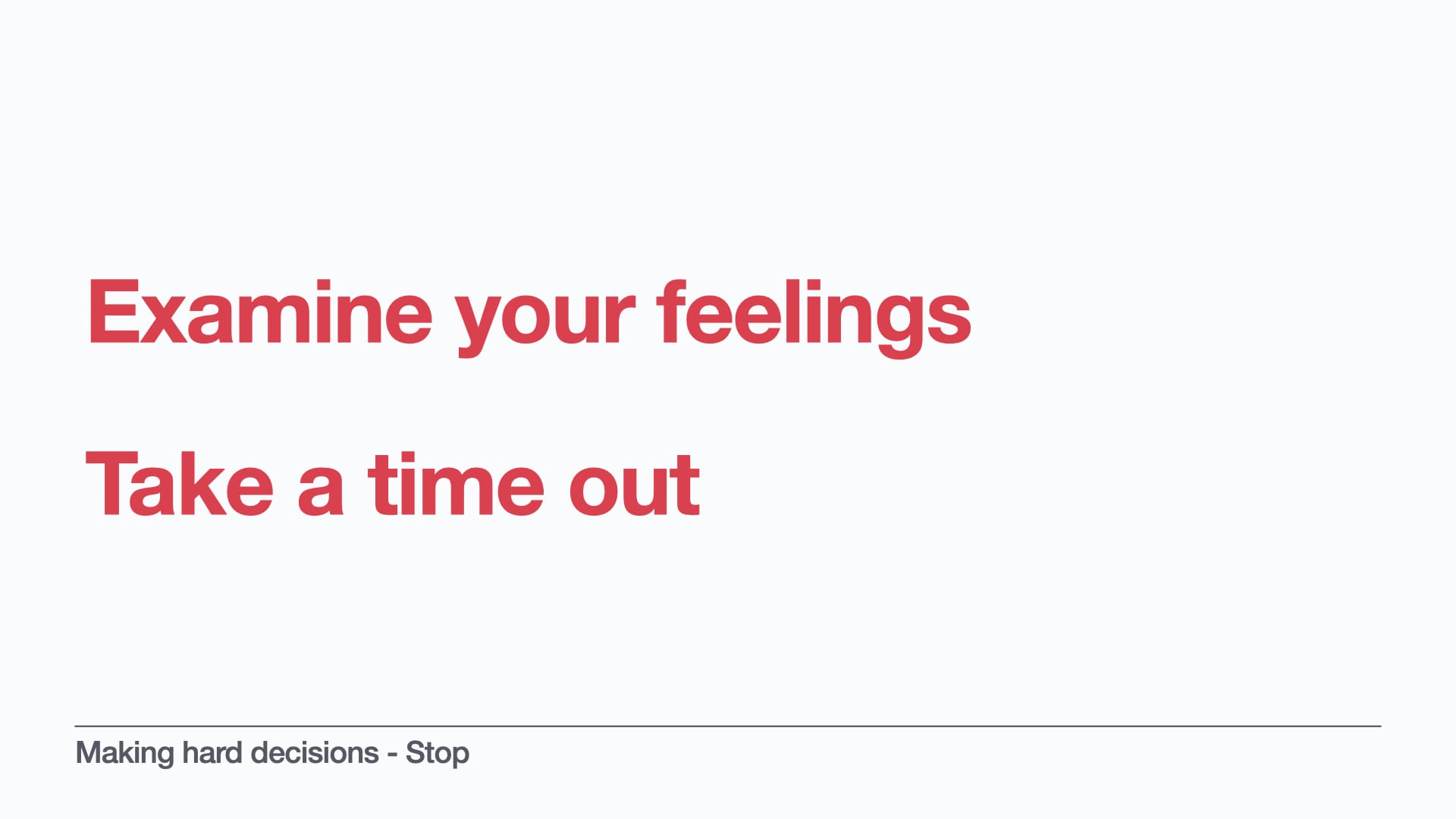
So you’ve taken the time in the moment to notice your feelings
Or you’ve put your hand up to say: time out, stop the line, we need to discuss this in more detail.
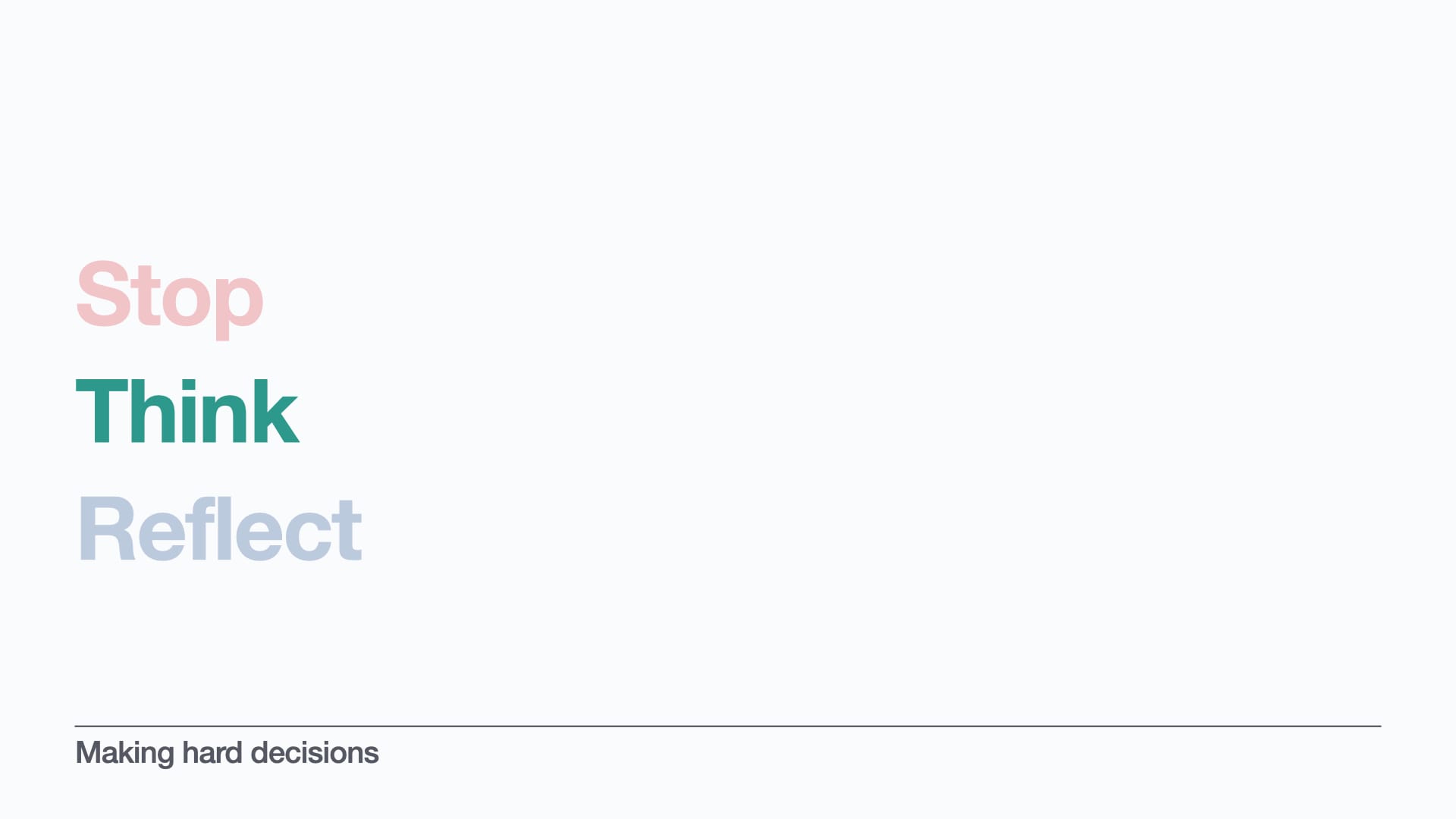
Now you’ve created the time and space to think.
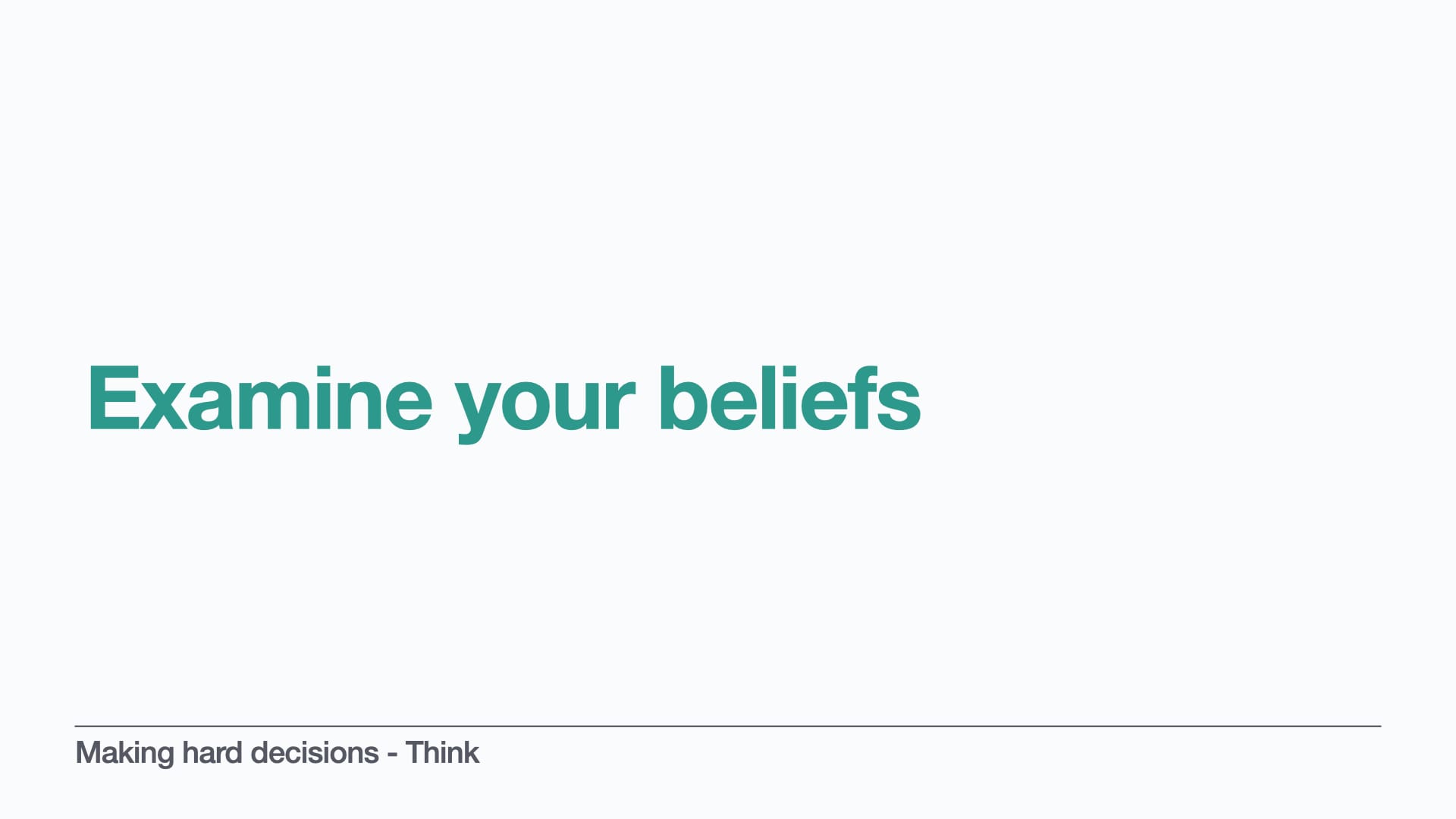
To gather more information. What can you do to examine your beliefs?
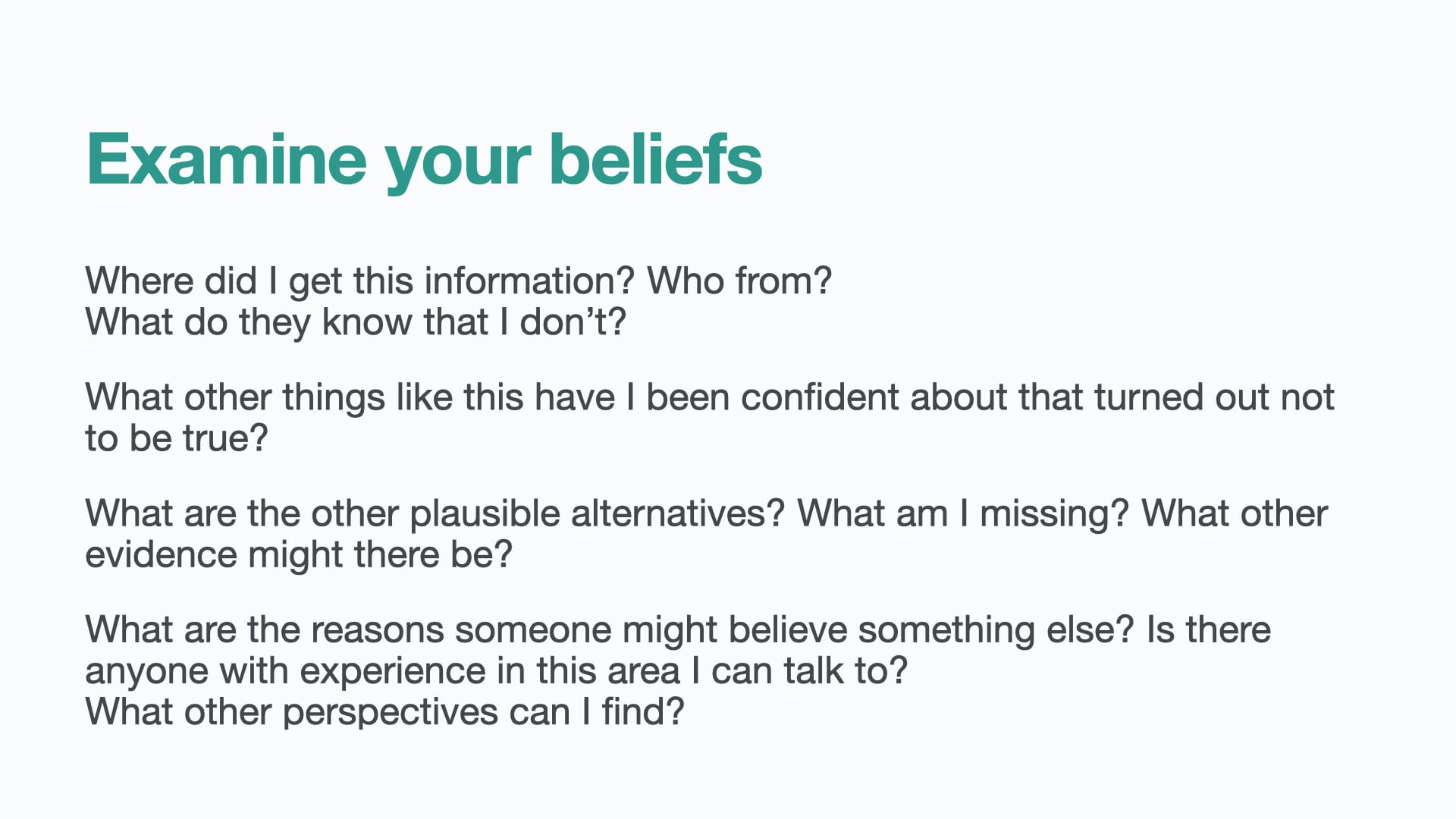
Here’s some questions you can ask yourself - or your team - to really interrogate yourself, and your beliefs, to get more information.
Questions you can ask to gather that all-important context that will help you make a better decision, because you learned more about the environment you’re operating in and the people around you.
This examination of our beliefs is about becoming continuously and vigorously curious. We need to get in the habit of asking ourselves these questions about every new piece of information.
And this is not the end of the list, it’s just all I could fit on a slide - you can probably think of loads more different and better questions.
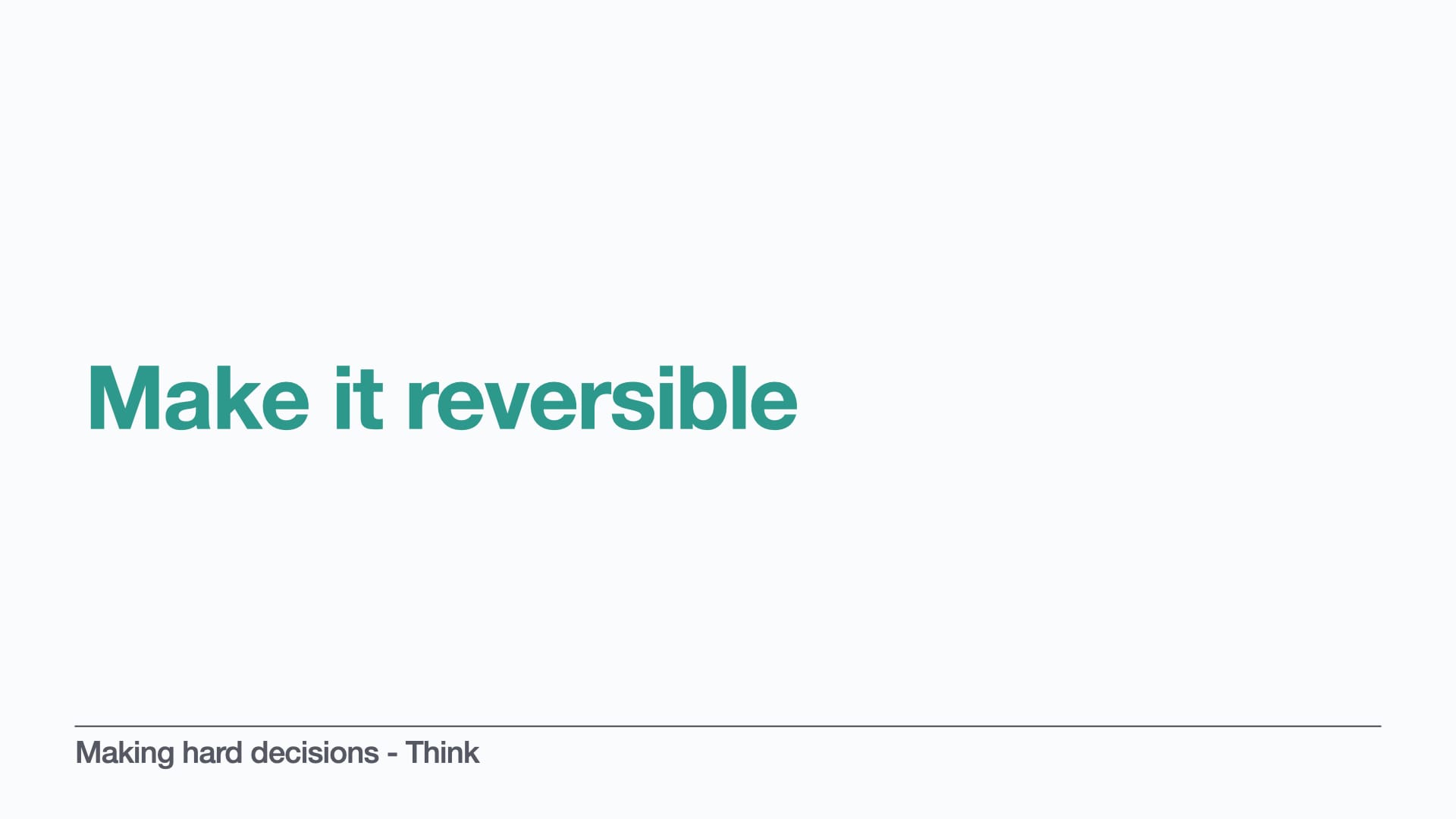
Did your decision fail the two way door test because it wasn’t reversible? In that case, think again. Is there a way you can make it reversible?
We already do this with hiring - we have probation periods (on both sides!). Is there a way you can trial a new service or a new role in the team, before committing to it for the longer term?
At dxw we've just launched an initiative where we're having some of the engineers start to line manage other engineers, just one or two people. But we went to them with a plan of a no-harm, no-foul rule, that at any point, either party can back out with no worries. Make it obvious to the team that you've planned for that and it's ok if they change their minds.
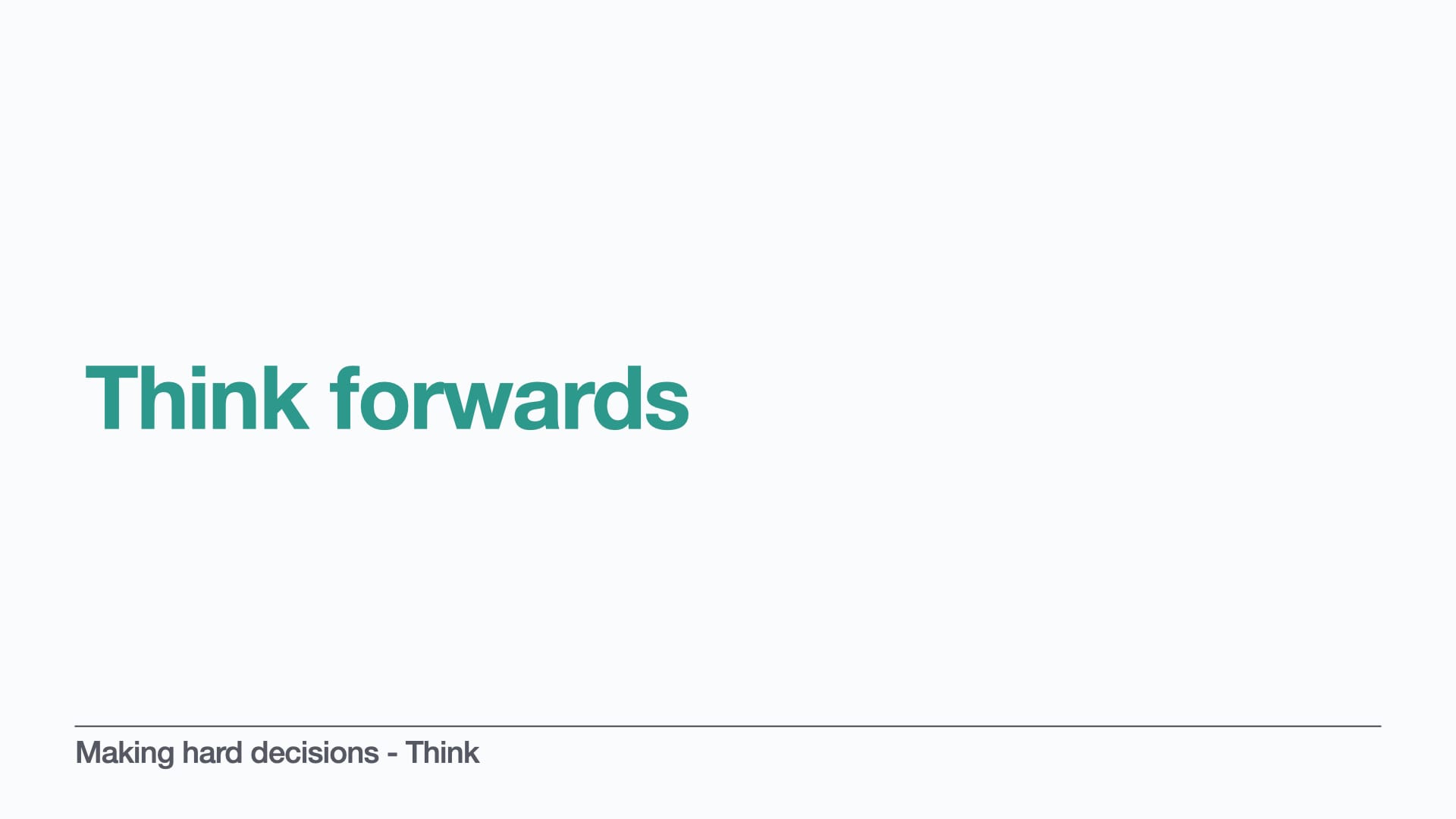
This idea has been really helpful for me. It’s sort of like mental time travel. Putting yourself forwards and backwards in time.
A few years ago, I was in a situation where - it was the first time - someone on my team had quit - we were all very sad about it because they are great.
And in the moment it felt like a bit of a surprise. But then when I looked back, I realised there had been rumblings, and there had been questions, from that person, that should have set my spidey sense tingling and made me realise how unhappy they were. But I’d missed the signs. I didn’t realise the situation was that serious.
And afterwards, my manager said to me: “Do you know what Nicky, this is a perfect time to ask ourselves:
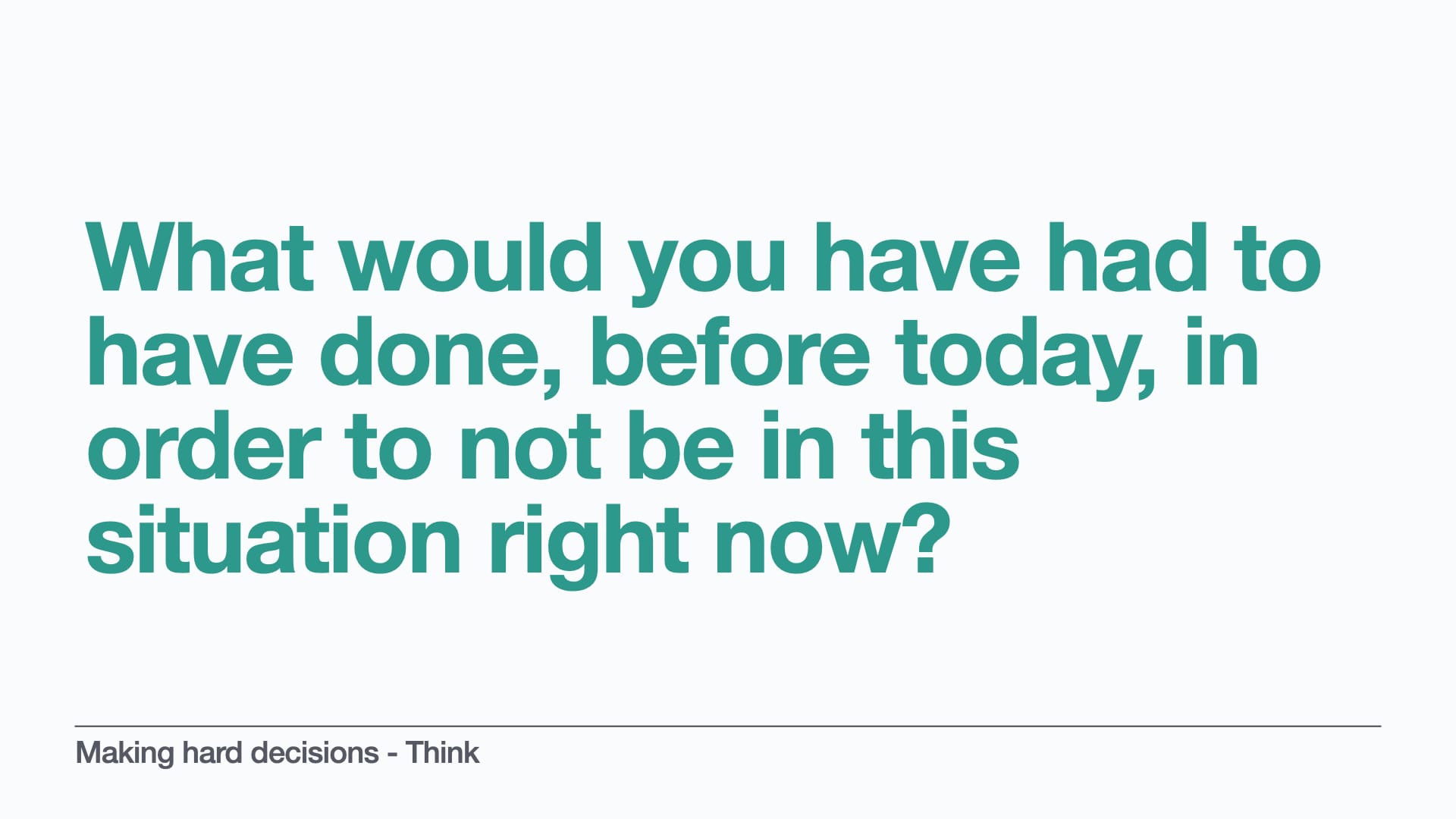
What would we have had to have done, before today, two weeks or two months ago, in order to not to be in this situation right now?”
And that might not sound like it was very helpful in the moment, but it was, and it did prompt that reflection, and from then on it prompted me to have that reflection earlier in all my thinking. Because, maybe, in that case, it was the right time for that person to move on, and that’s great for them, but also maybe we could have made the changes that they needed.
What this taught me is that we can bring that reflection forwards.
We don’t have to wait for the bad thing to happen: we can plan ahead, visualise the future, pre-game it and put ourselves in that situation ahead of time.
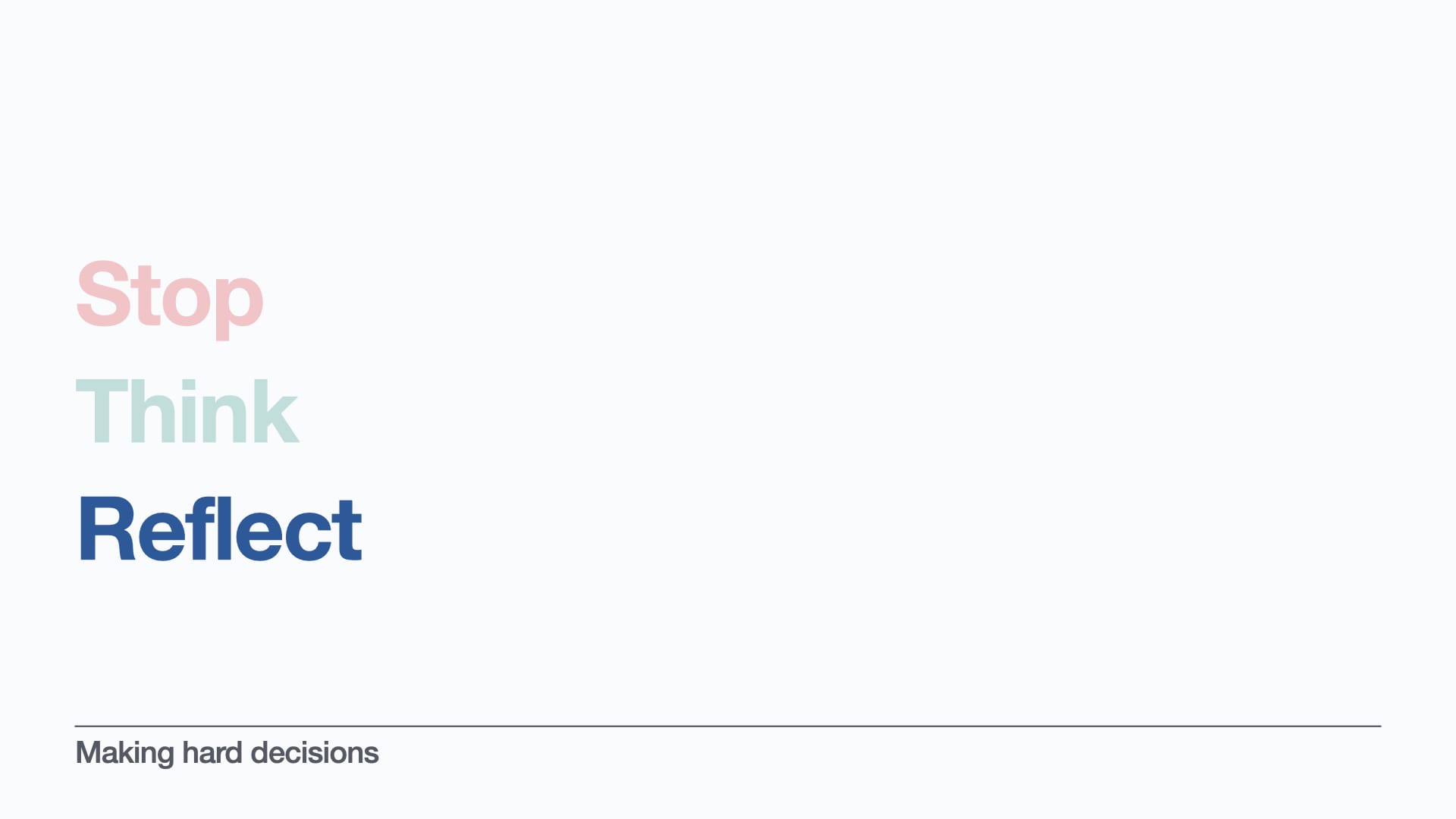
But sometimes you’ve already made what seems like a bad decision in hindsight
Perhaps you didn’t call the time out and you got rushed into something
Once you’ve done the cleanup and made it right..
Now’s the time to learn from that.
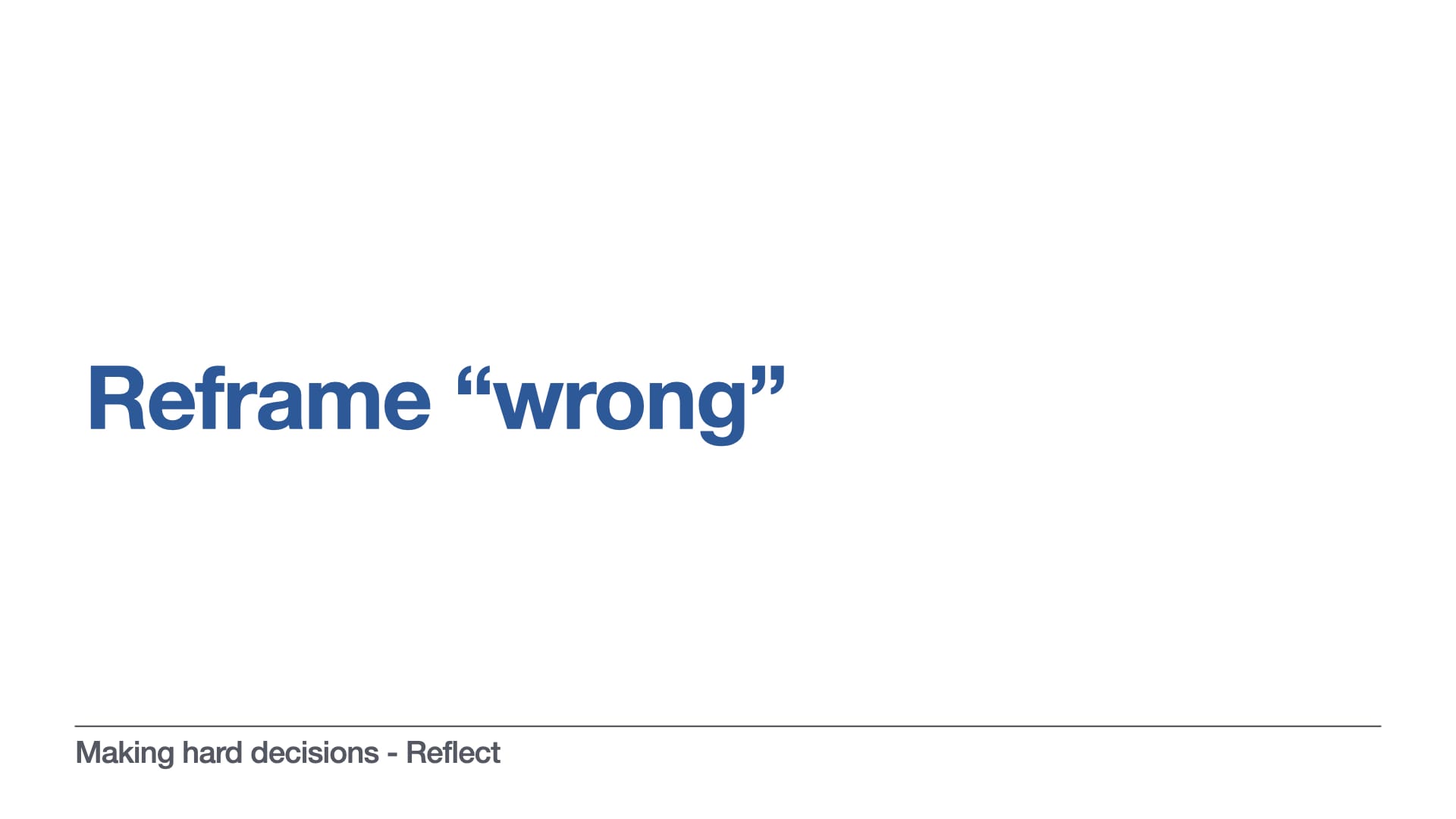
This is a mindset shift. Reframe “wrong”.
Being wrong, or being told that you’re wrong, feels bad. It feels like an attack on our identity!
Remember that we want to think of ourselves as those rational actors. If we think of beliefs as 100% wrong or 100% right, then something comes up that contradicts that, we only have 2 options: 1: we can make a big change to our identity “hang on, I’m now somebody who believes the complete opposite, of what I thought before” or 2: use our smart intellect to discredit the new information. It’s hard to change our minds.
So, often, we don’t.
So we need to get in that habit of examining our beliefs.
The more we do that, the more we find that being wrong is not always bad. It means you learned something. Now you have more information.
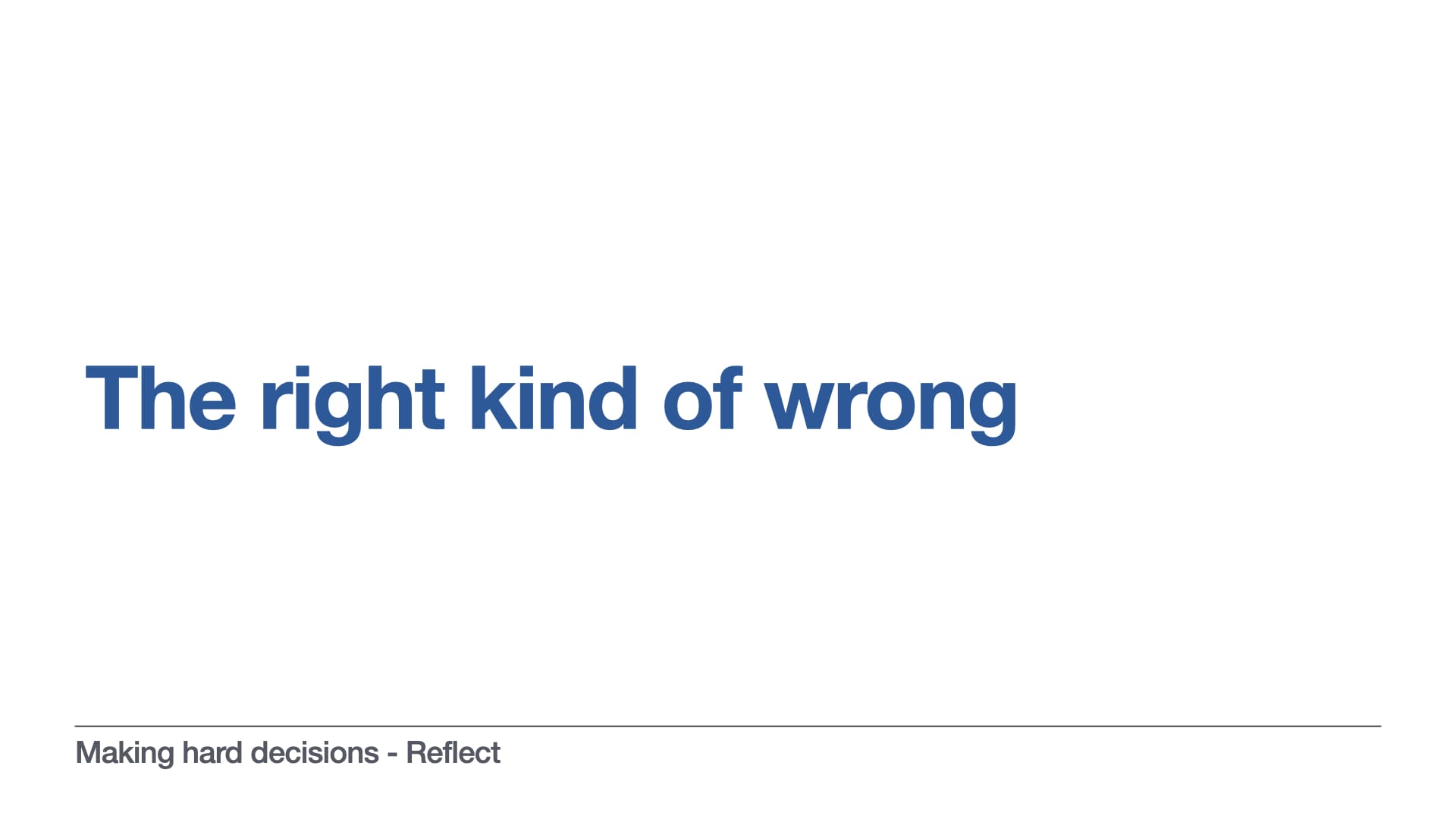
Amy Edmondson is a Professor of Leadership at Harvard Business School and she’s got multiple degrees in organisational behaviour, psychological safety, all that good stuff. And she’s written a book called “The Right Kind of Wrong”
Amy shared this idea of “intelligent failure”. And the first time I heard this, I thought, well, this is a weird idea, how can it be good to fail? Failing is not winning, making mistakes feels bad, trying to avoid that sinking feeling, y’know.
But Amy says:
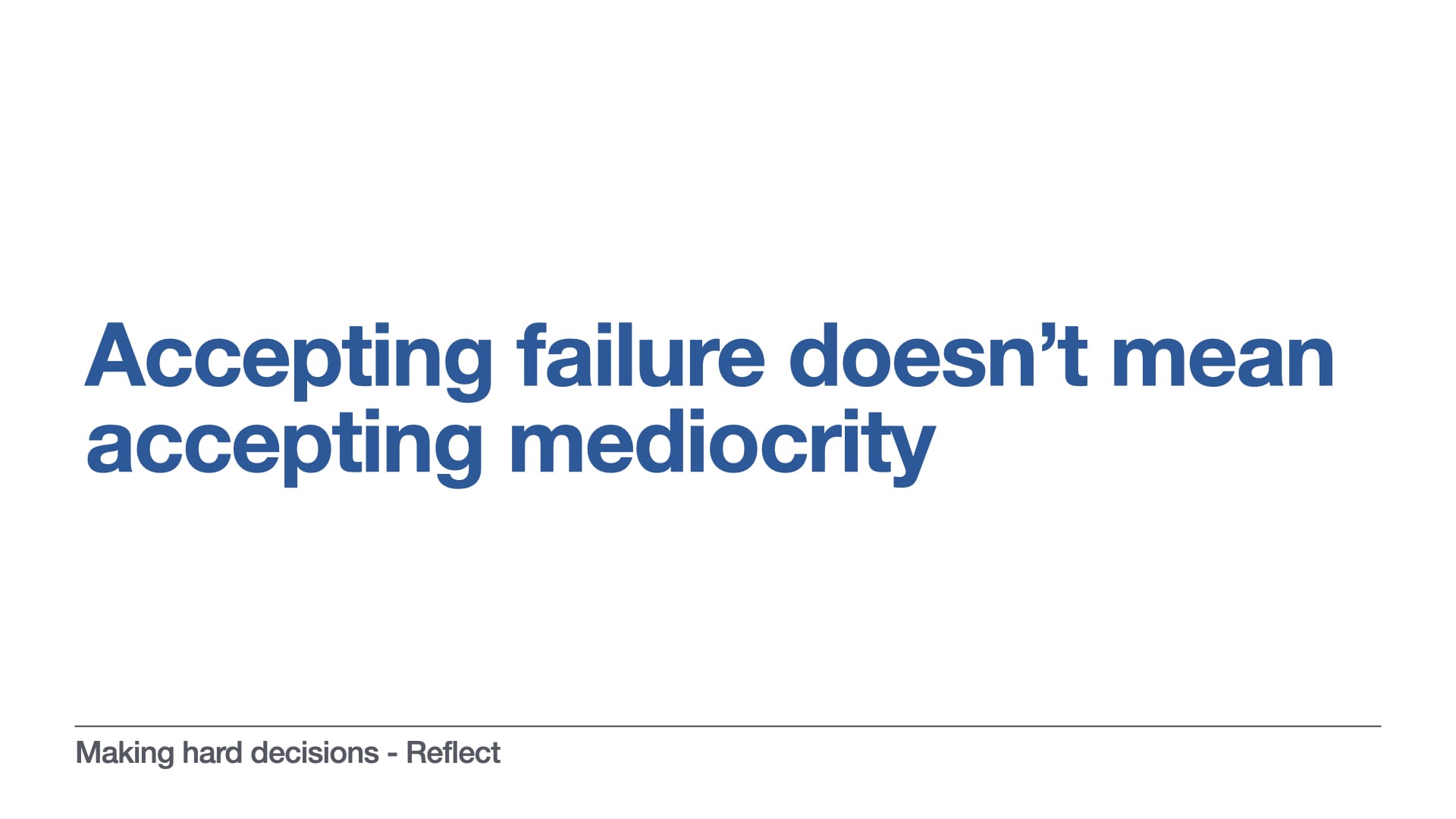
Accepting failure doesn’t mean accepting mediocrity.
Because to experience intelligent failure, you have to be willing and able to engage in smart experiments
You have to do your homework. You have to think clearly about what might be possible
View what’s known and what’s unknown. And then you’re taking a smart risk
You hope it succeeds of course, but it won’t, often, because you’re doing something new and ambitious and you didn’t have a crystal ball.
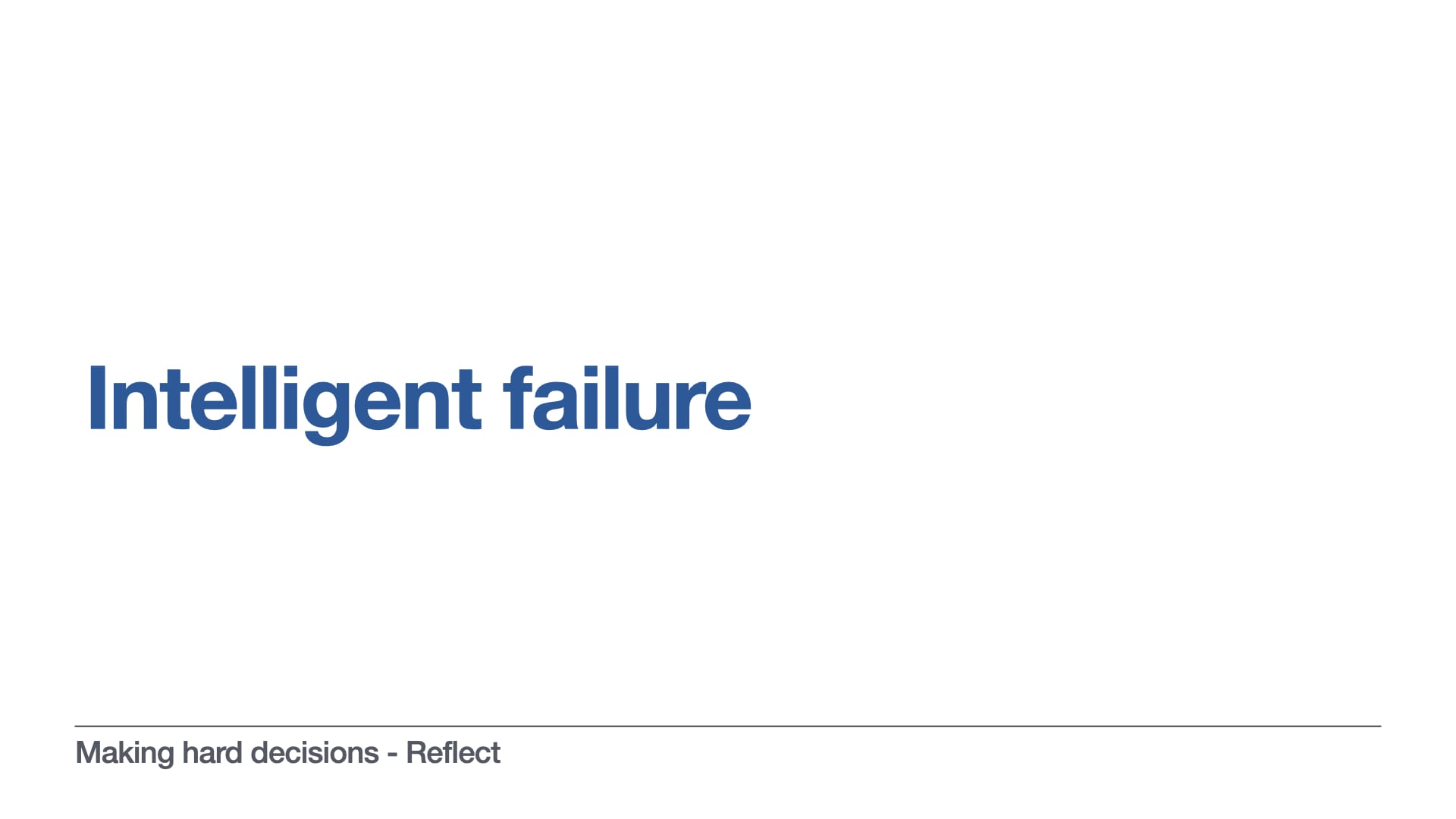
And this made me realise, this is when I got that sinking feeling - when I was “the wrong kind of wrong”.
When I needed to do my homework, and I hadn’t.
And it's a bit weird, because nobody wakes up thinking “Oh, gosh, I hope I fail a lot today!” But - if we can make them intelligent failures, if we do our homework, if we stop and think, if we examine the accuracy of our beliefs, then we’re setting ourselves up to be the right kind of wrong, to fail better.
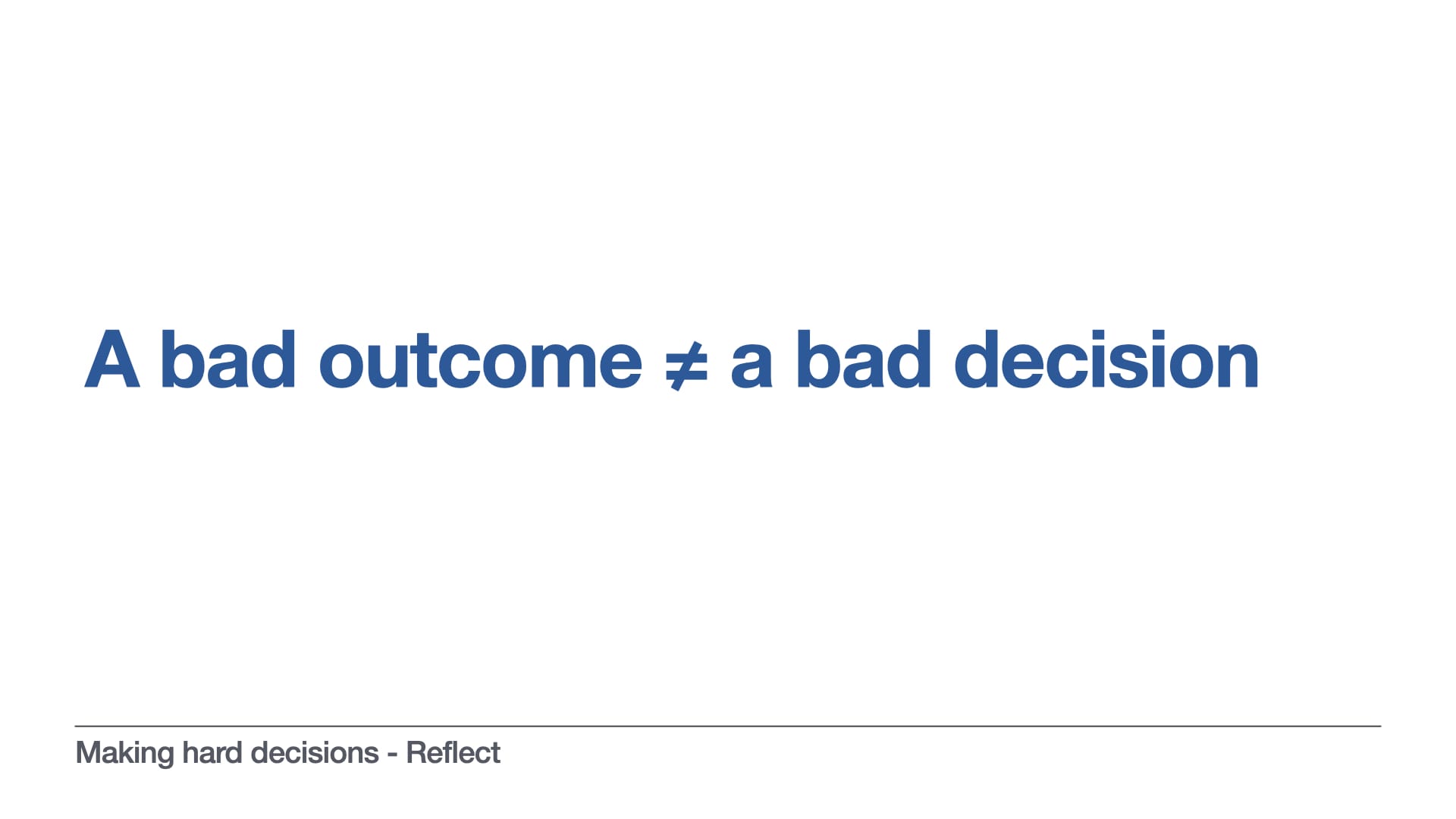
So what happens when we don’t get the outcome we wanted?
Well, if we think about “making mistakes” and “intelligent failures” and “being wrong” as ways of learning, then we can get to this place where we can realise that another bias might have just crept in - hindsight bias. That means, judging the result of a decision based on it’s outcome, not on the quality of the assessment that led you to make that choice. A bad outcome doesn’t necessarily mean you made a bad decision. The dice is being rolled - we can’t control every aspect of our environment.
The flip side of this of course is that:
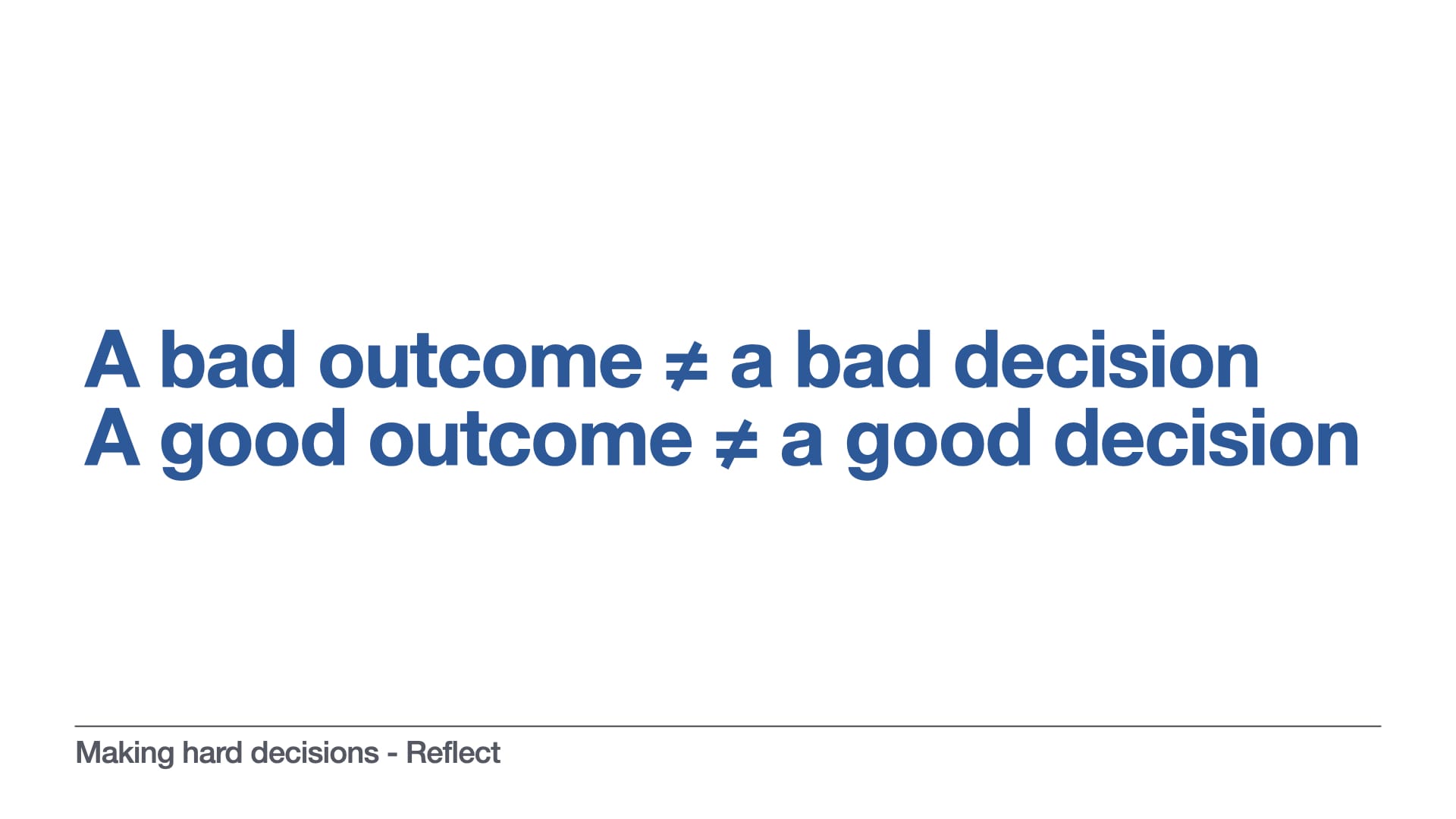
A good outcome doesn’t necessarily mean you made a good decision, either. The dice is being rolled - it might have been in your favour.
This means, we need to interrogate the process that led us to good outcomes, just as much as we do for when things don’t go our way.
But if we focus on the things we can control, if we’ve done our homework, we can be more confident that the outcome was due to something that was not in our control.
And we will still feel bad, because we didn’t get the outcome we wanted. And if the outcome affects other people, then we probably will feel even worse, because we care, and we are kind, and we will own the result and do what we need to do to fix it.
But we don’t have to beat ourselves up about it, because we know we followed the steps, we examined our beliefs, we did our homework, we didn’t make quick decisions when we should have made slow ones. But regardless of whether we get the outcome we want or not, we must still always interrogate the decision making process that led to it.
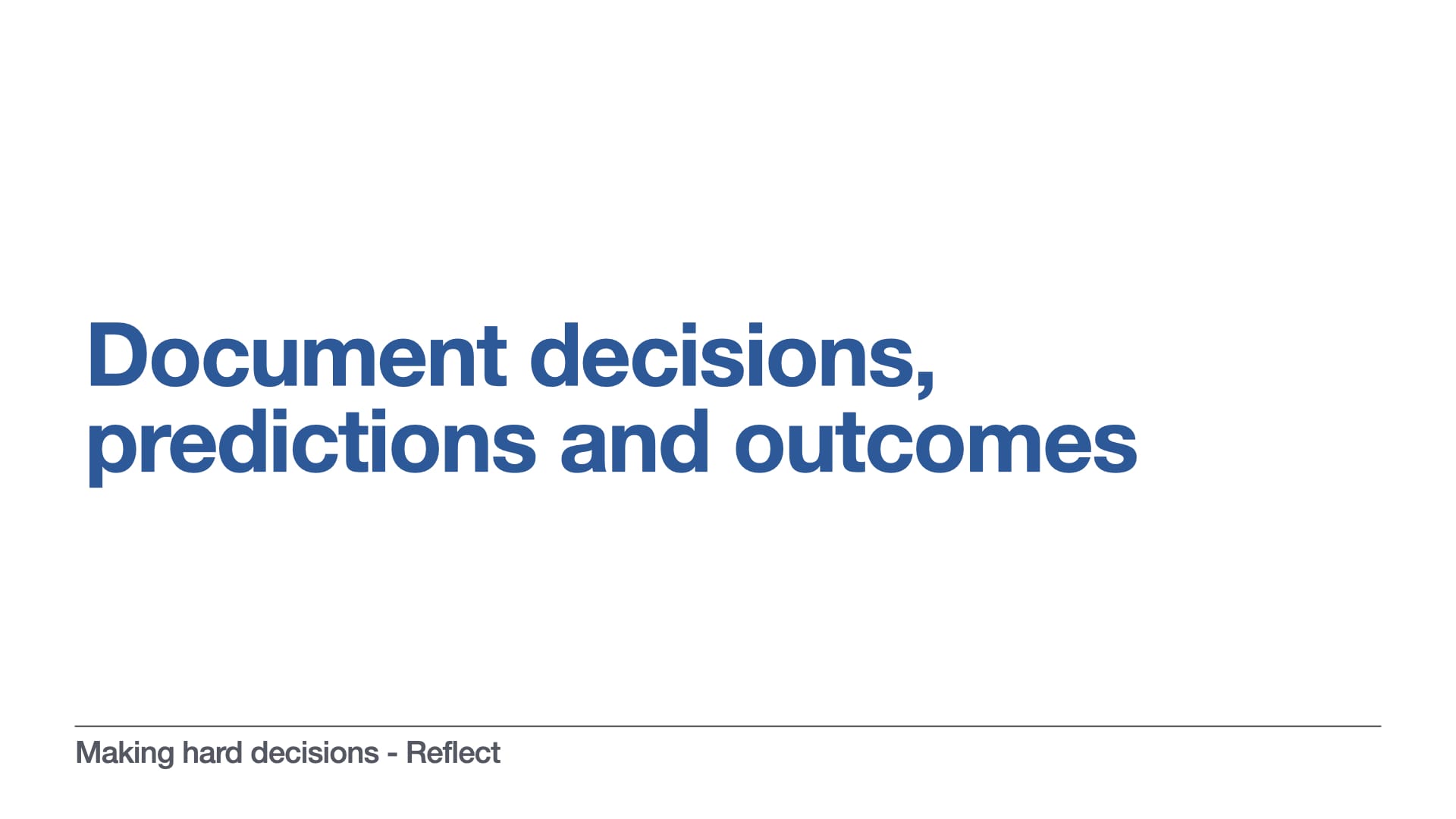
And document it! Write it down - what you’re planning to do, and what you think will happen. And then write down what did actually happen. Look back on it regularly, and it will become a record of your experiments - and you’ll be able to fine-tune your future decisions and hopefully improve your success rate.
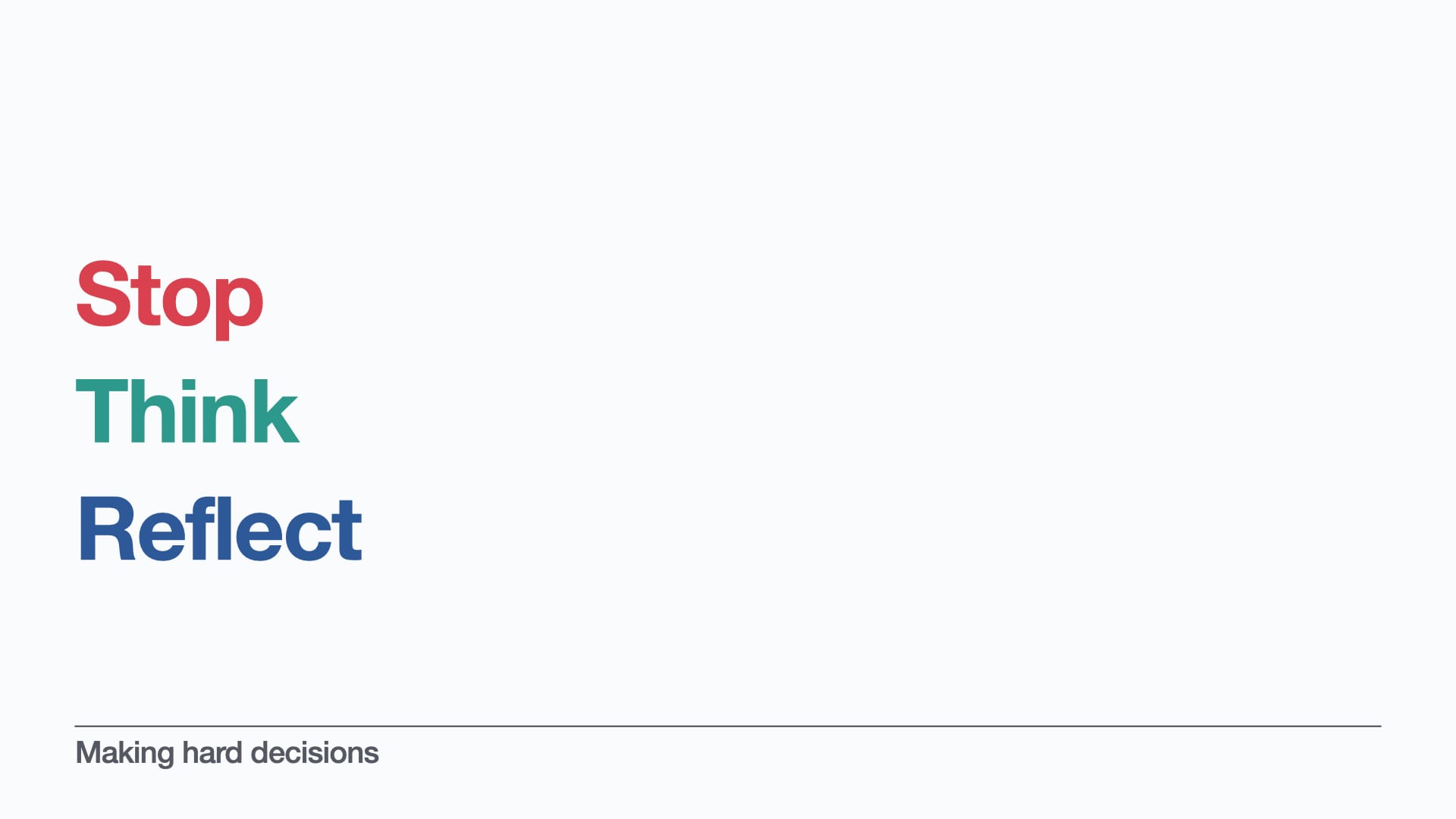
So that’s how to make hard decisions! Easy, right?
We saw how to create space to stop and think, and that we need to get in the habit of examining our beliefs, so that when we are - inevitably - sometimes wrong, we don’t have to feel defensive about it, but we can embrace a change of mind, because it means we’ve learned something.
And we learned that we must analyse our successes as much as our failures, because otherwise we’ll never learn if it was our good decision making, or just chance, that led to our good outcome.
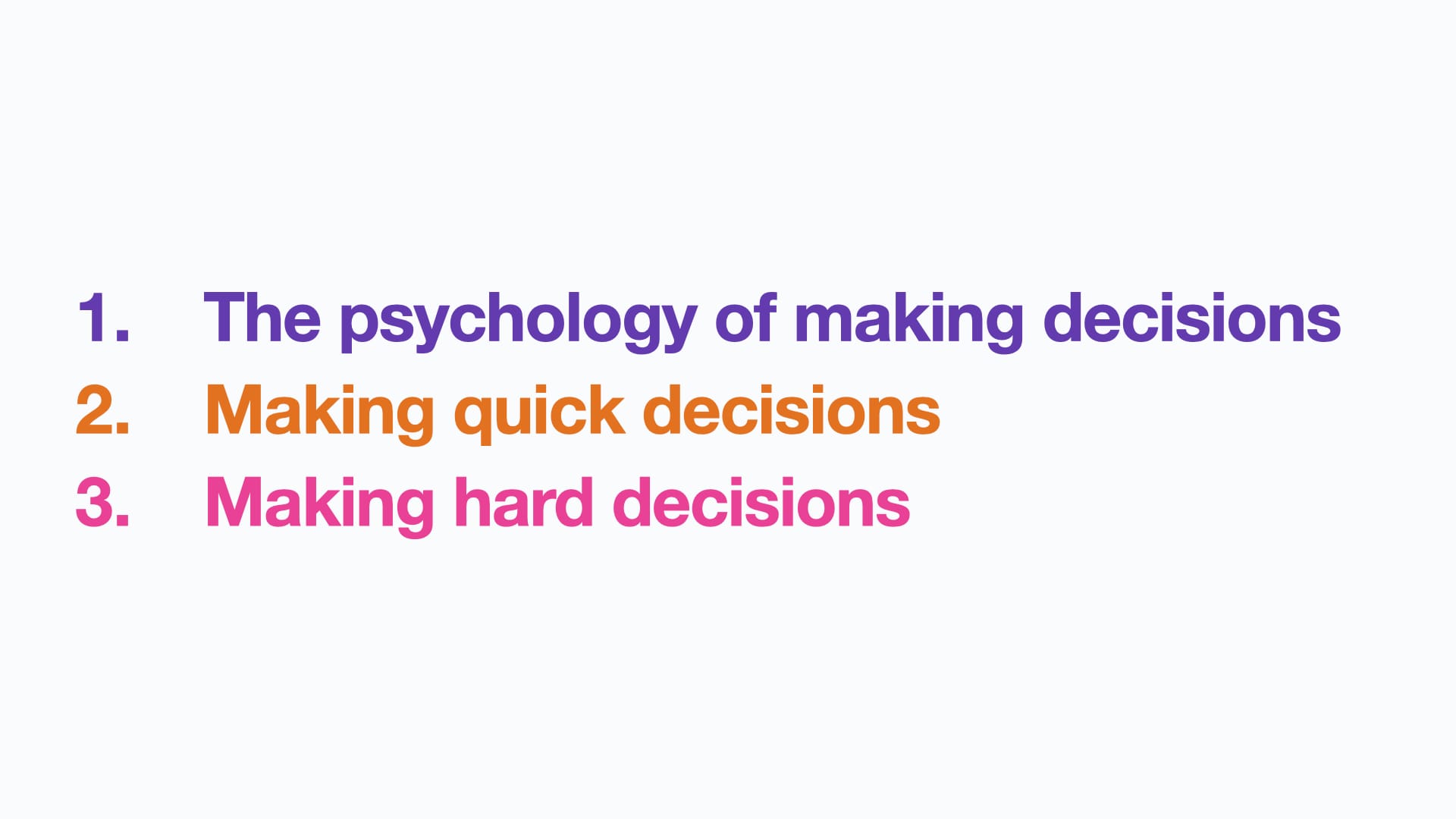
So that’s almost it for today.
We’ve learned more about the psychology of decision making, how our brains work and some of the cognitive traps it’s easy to fall into.
We’ve looked at how to make quicker decisions when we can.
How to slow down, and be vigorously curious.
To get in the habit of interrogating our beliefs to get to the truth.
To do our homework and view all the possibilities.
And whether we get the outcome that we want or not, to record them so we can increase the success of our predictions.
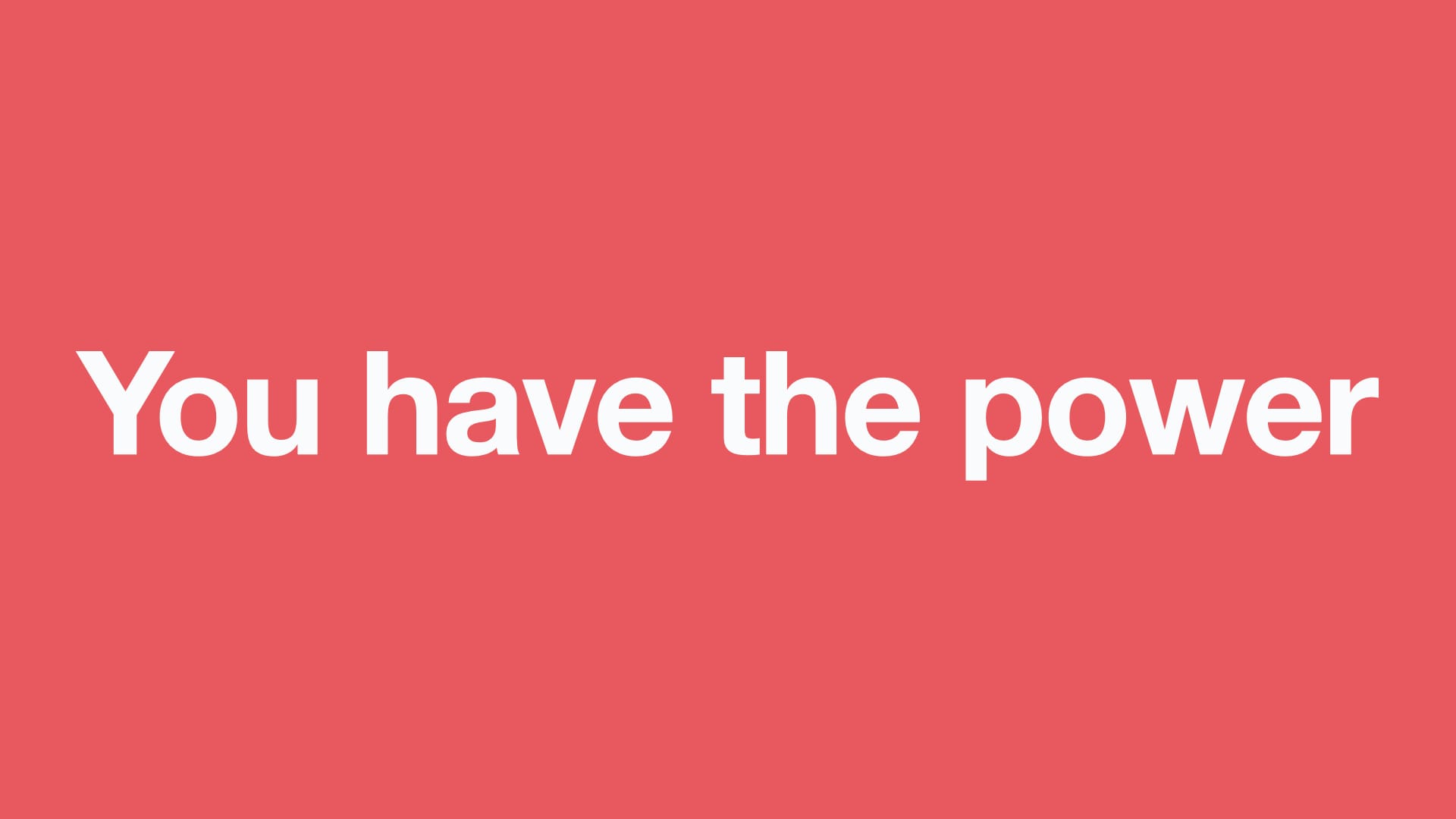
And we should do these things. Because you’re in these positions now. You gotta make the hard calls.
Because we have the power to make work better.
And it’s hard, but it’s important.

So I hope you don’t have to feel like you’re scared of being on this rollercoaster and instead you can enjoy it and make work - and life - less stressful for you and for the people around you. Thanks for listening.
References
Here's a list of references I used while writing my talk:
- The Biggest Bluff - Maria Kournikova
- Thinking in Bets & How to Decide - Annie Duke
- Thinking, Fast and Slow - Daniel Kahneman
- The Right Kind of Wrong - Amy Edmondson
- How to Make the World Add Up - Tim Hartford
And some other ideas that informed my thinking, but weren't mentioned in the final talk:
- Thinking in a foreign language at Wired and thinking in a foreign language at the Guardian
- Hillel Wayne writing on sleep at X/Twitter and writing on sleep at Increment
- Managing at the threshold - David Yee
- Habits of highly effective teams - Charity Majors
Image from Ever at Flickr